
#1 DVD Ripper 1.3.42 serial key or number

#1 DVD Ripper 1.3.42 serial key or number
 |
It's been over eight (8) years since I built a PC with the last one being in 2010, a Core i7-980X (destiny), which was back when Intel actually produced motherboards!
destiny is my main home workstation. I use it for some VMs, video encoding, photo editing, and the occasional game (Quake III Arena and Quake 4). For the last two years I mulled over upgrading it to something more modern, even though my workloads on it didn't really justify the upgrade. This year, I decided to pull the trigger and upgrade it to something that'll last for another 8 years. I looked at the Ryzen ThreadRipper series and even added a few builds to my cart, but then realized it was probably going to be a waste since 99% of the time the plethora of cores won't be used. So, I decided to look at the leader in single thread performance, which turned out to be Intel:
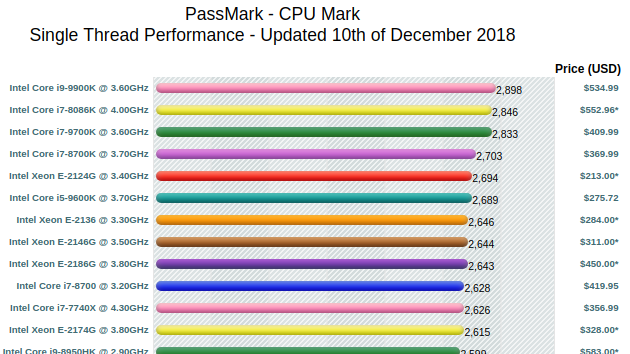
(source for the above screenshot is here)
AMD doesn't even make it to the top 10. Since the i9-9900K had just been released by the time I was looking, I decided to go with it. Here's the build:
New components:
- Motherboard: MSI MEG Z390 ACE
- CPU: Intel Core i9-9900K
- Cooler: Cooler Master Hyper 212 EVO
- Memory: 4x8GiB Corsair Vengeance LPX DDR4-2666 (32GiB total)
- PSU: Corsair RM850x
- Case: Corsair Carbide 200R
Existing components:
- SATA SSDs: OCZ Colossus 256GB, Crucial M500 960GB, Crucial m4 256GB
- SATA Optical Drives: LG Electronics BH16NS40 Blu-ray Rewriter, Pioneer PIO-BDR-211UBK MAIN-16374 Blu-ray Rewriter
- Video Card: eVGA GeForce GTX 1050 Ti SC
The OCZ SSD is pretty old and a 3.5" form factor but it's still working so I have it mounted in ~/tmp for scratch space. I'll probably replace it or some of the other SATA SSDs with M.2 SSDs if it turns out I need more space. Right now, it's not a priority for me. The Blu-ray optical drives limited my choice in cases, but the 200R is a really nice case and another one of my systems uses the same one so I've got experience with it.
The integration was, honestly, pretty easy. I expected more of a fight. It was a little tricky to get the Cooler Master heat sink oriented and attached to the processor but I wasn't in a rush and took my time.
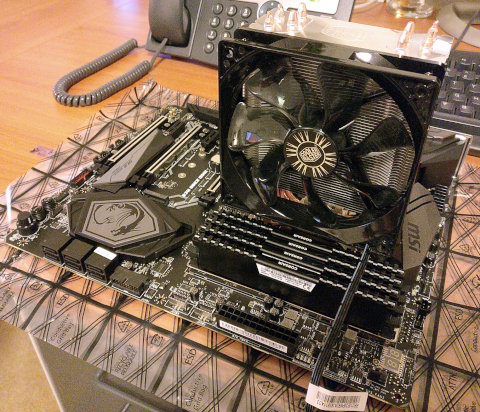
I had fully intended to use the old 850 watt Corsair power supply that I had used on my i7-980X system (TX850w) but it lacked the 2x CPU power connectors so I went for a new RM 850x. Anyway, here's the [almost] final build:
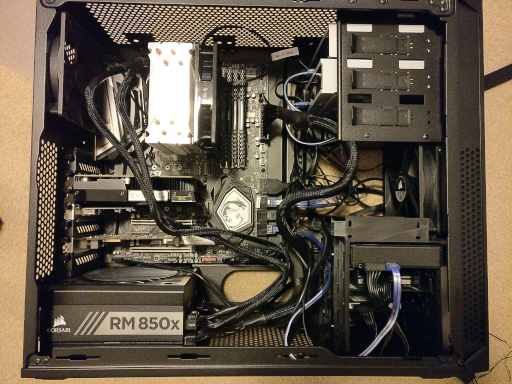
I say almost final because the OCZ SSD gave me some problems. The power and SATA connectors on it stick out pretty far, so the case wouldn't close. I even tried the L-shaped SATA connector that came with the MSI motherboard but that didn't work, either. At the end of the day I just took it out of the 3.5" bay and placed it "free" in the case. Yes, this is horrible and more of a reason for me to replace it with an M.2 SSD in the near future.
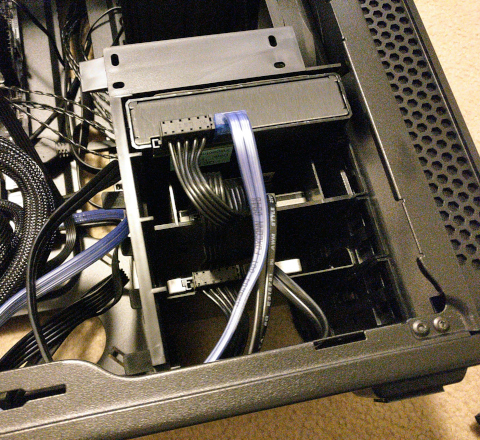
Actually, I can see the above problem happening for any full 3.5" drive, which is a little weird. Here's the final result:
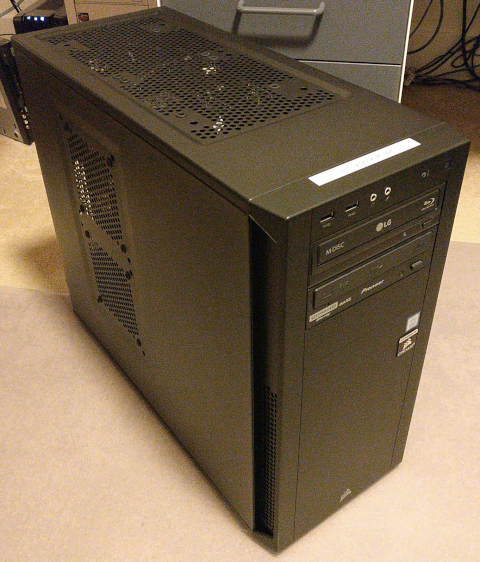
Unlike many PCs I've built in the past, this one worked the first time! After assembling everything the BIOS indicated to me that everything was set to defaults, so I explored a little bit of the BIOS and then booted the OS.
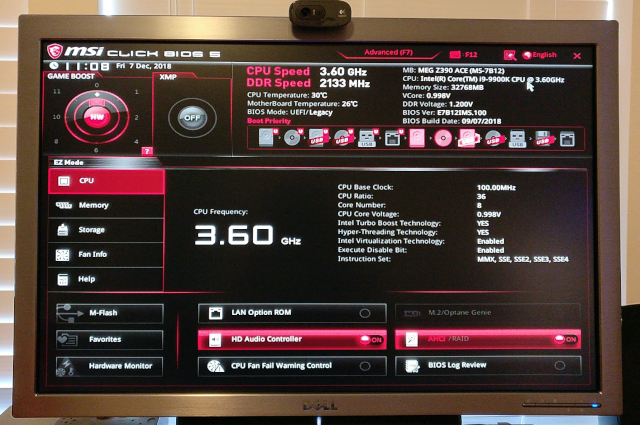
The BIOS is really slick, BTW. I'm not one to like GUIs but it's nice to actually see a map of the board with annotations of what's connected to what. &nbs;The one thing that I still think I need to change is the memory speed. Without OC'ing, Intel rates the memory speed of the i9-9900K at 2666 MHz, which is the speed of the RAM I have. It's running at 2133 MHz right now.
I booted up Linux and did some tests running HandBrakeCLI and messing with cpufrequtils. While I can set the processor to run at 5.00 GHz, it throttles itself down to 4.70 GHz under full load at 77°C, which seems fine to me. The default governor is powersave, which runs all cores at 800 MHz during idle times and actually results in lower TDP than the 980X.
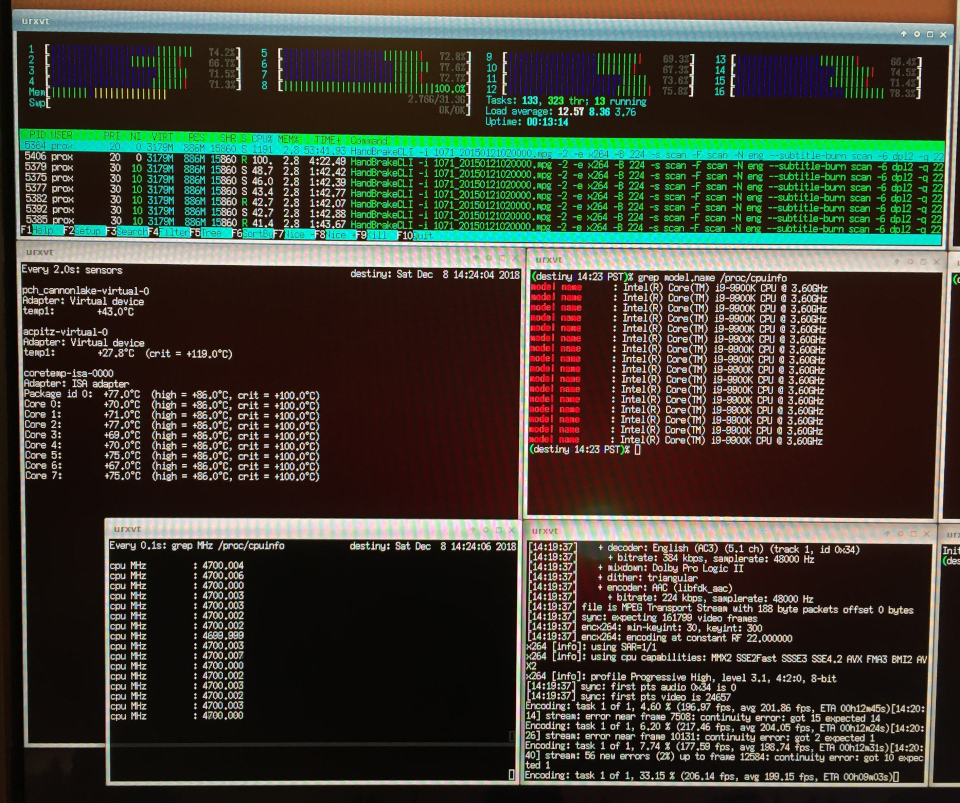
(sorry for the photo instead of a screenshot, but I was lazy)
It's been awhile, so I also fired up Quake 4, which was super smooth even with the quality turned up. Although, most of that is GPU-heavy and even at max vsync (60FPS) only half a core was utilized during gameplay.
I'll probably have some updates here to share over the next few days but for now, I'm happy with the upgrade. The system feels considerably faster and compared to the 980X, it definitely is:
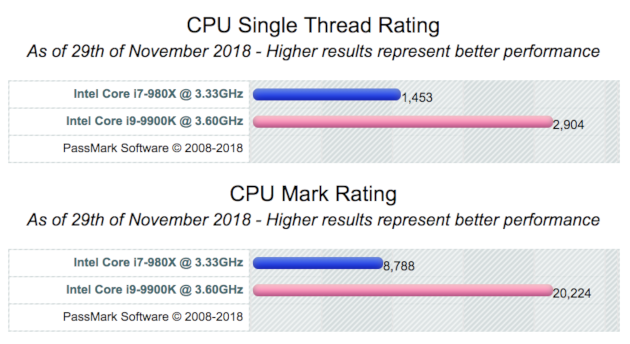
(source for the above screenshot is here)
Find dmesg, cpuinfo, and lspci output here, if you're curious. All grainy cellphone photos are here, too.
tl;dr I ran into a boot loop issue with my NordicTrak treadmill. Turning off NTP solved the problem.
My wife and I purchased a NordicTrak C 990 treadmill in late 2016. It doesn't get all that much use (I still prefer going to the pool and swimming) but we both periodically use it. I have an iFit membership that's mostly a waste of money but allows the machine to report and track my workouts online.
The control plane of the machine runs Android 2.x and has always felt pretty brittle outside of the iFit application. Connecting to Wi-Fi, for example, is done through the Android system dialog screens rather than through an iFit-branded screen.
Anyway, the whole system was working fine until I decided to use it today. I put the key in and Android indicated it couldn't connect to Wi-Fi. So, I power cycled the system (naturally). Upon reboot the iFit screen would load but then after 10-15 seconds trigger a reboot of Android. I searched around and found instructions like this that described how to reinstall the iFit application. However, these instructions didn't work for me because even if I could draw the "figure 8" on the screen to exit the iFit application's splash page, the OS would still reboot seconds later.
I took a guess that something Wi-Fi-related was causing the reboot so I shut the 2.4GHz radios on my two Cisco WAPs (the treadmill is one of two devices that still use 2.4GHz only). The reboots stopped. Something network-related was definitely causing it. Maybe it's some update check that is returning a value that is triggering a bug in Android? So, I ran tcpdump(8) on my local router. I started a continuous ping and the last packets transferred before the system rebooted were NTP queries. Thinking that something time-related was killing the OS I went into Android settings and disabled network-provided time. The system was still stable after boot even when Wi-Fi is on, now.
The system date was 2012-01-01 so I tried setting it to 2018-04-03. Instantly, the system locked up and after a few seconds rebooted. I even tried setting it to a last known good date earlier in the year when I knew the treadmill was still working - same thing, triggered a reboot. It would appear that either something in the OS can't handle the date changing too drastically or there's something that can't handle a 2018 date.
So, the treadmill is functional but I now can't login to my iFit account. I'm guessing that somehow the date is passed as one of the login parameters and the iFit platform rejects the login attempt. I'll play more with it later and will not be renewing my iFit membership if I still can't login.
Hopefully this post will be useful to someone who's given up and about to buy a new treadmill..
Update: I played around with setting the date a bit more. Even setting it to 2012-01-02 triggers a reboot. It would appear the date can't actually be set, now.
From the RPi annoyances department..
I did a kernel upgrade on one of my Raspberry Pis earlier today by installing the latest raspberrypi-kernel from testing (1.20170515-1). It installed Linux 4.9.28+ and I instantly realized there was something wrong since the Wi-Fi was very latent and would periodically disconnect from any nearby WAPs. I use the Edimax EW-7811u USB stick since this Raspberry Pi is one of the original model Bs without Wi-Fi.
After debugging a bit and searching the Internet it appeared that I was now using the wrong driver, rtl8192cu instead of 8192cu:
(henry:22:18:PDT)% uname -a Linux henry 4.9.28+ #998 Mon May 15 16:50:35 BST 2017 armv6l GNU/Linux (henry:22:19:PDT)% lsmod|grep -i rtl rtl8192cu 79230 0 rtl_usb 12234 1 rtl8192cu rtl8192c_common 57894 1 rtl8192cu rtlwifi 85339 3 rtl_usb,rtl8192c_common,rtl8192cu mac80211 650547 3 rtl_usb,rtlwifi,rtl8192cu cfg80211 525710 2 mac80211,rtlwifiApparently, before this upgrade the 8192cu driver was being used. So, I added "blacklist rtl8192cu" to /etc/modprobe.d/raspi-blacklist.conf and rebooted. Bingo, the right module is now being used:
(henry:23:04:PDT)% lsmod|grep 8192 8192cu 597868 0 cfg80211 525710 1 8192cuNo more Wi-Fi drops!
As I was doing upgrades on a few of my Raspberry Pi machines (running Raspbian), I ran into a situation where apt-get would SIGABRT on any action. Depending on the shell, the message to the user is a little different and also overwrites a different amount of APT's status message. Here's Zsh:
(storm:20:50:EST)% sudo apt-get --purge remove quagga-pimd quagga-isisd quagga-ospfd quagga-ospf6d zsh: abort sudo apt-get --purge remove quagga-pimd quagga-isisd quagga-ospfdHere's Bash:
prox@storm:~$ sudo apt-get --purge remove quagga-pimd Aborted package lists... 48%No matter what the operation (install, upgrade, update, remove), APT would just get a SIGABRT. There was nothing in the kernel log buffer and the RPi 3 I was on at the time wasn't out of disk space or memory. Since this RPi had just completed a dist-upgrade and I had rebooted it, everything was more-or-less up-to-date with the "testing" channel of Raspbian. I searched the web and couldn't find anything related to "abort" or "SIGABRT" on Debian or Raspbian. There were also no bugs filed against any of the relevant packages. So, I figured that I had just hit a bug and started downgrading. I used dpkg-repack on another RPi 3 of the following packages, which I downgraded to:
apt_1.3~rc4_armhf.deb
apt-utils_1.3~rc4_armhf.deb
dpkg_1.18.10_armhf.deb
dpkg-dev_1.18.10_all.deb
libapt-inst2.0_1.3~rc4_armhf.deb
libapt-pkg5.0_1.3~rc4_armhf.deb
libc6_2.23-4_armhf.deb
libc6-dbg_2.23-4_armhf.deb
libc6-dev_2.23-4_armhf.deb
libc-bin_2.23-4_armhf.deb
libc-dev-bin_2.23-4_armhf.deb
libc-l10n_2.23-4_all.deb
libdpkg-perl_1.18.10_all.deb
locales_2.23-4_all.deb
multiarch-support_2.23-4_armhf.deb
On the upgraded RPi, I'd been running APT 1.4~beta4, libc 2.24-9, and dpkg 1.18.18. Unfortunately, none of the downgrades did the trick. My next step was to downgrade the kernel, but I started to think something was maybe gummed up with APT itself, possibly in its database since it always received the SIGABRT about 50% of the way through reading package lists. I ended up looking up the various storage directories and decided to clear out /var/lib/apt/lists. I did another apt-get upgrade and things started working again:
(storm:21:55:EST)% sudo apt-get update Get:1 http://archive.raspberrypi.org/debian jessie InRelease [22.9 kB] Get:2 http://mirrordirector.raspbian.org/raspbian testing InRelease [15.0 kB] Get:3 http://archive.raspberrypi.org/debian jessie/main armhf Packages [141 kB] Get:4 http://mirrordirector.raspbian.org/raspbian testing/main armhf Packages [11.7 MB] Get:5 http://archive.raspberrypi.org/debian jessie/ui armhf Packages [53.6 kB] Get:6 http://mirrordirector.raspbian.org/raspbian testing/contrib armhf Packages [56.0 kB] Get:7 http://mirrordirector.raspbian.org/raspbian testing/non-free armhf Packages [95.1 kB] Get:8 http://mirrordirector.raspbian.org/raspbian testing/rpi armhf Packages [1,360 B] Fetched 12.1 MB in 24s (493 kB/s) Reading package lists... Done (storm:21:59:EST)% sudo apt-get --purge remove quagga-pimd quagga-isisd quagga-ospfd quagga-ospf6d Reading package lists... Done Building dependency tree Reading state information... Done The following packages were automatically installed and are no longer required: libquagga0 quagga-bgpd quagga-core quagga-ripd quagga-ripngd Use 'sudo apt autoremove' to remove them. The following packages will be REMOVED: quagga* quagga-isisd* quagga-ospf6d* quagga-ospfd* quagga-pimd* 0 upgraded, 0 newly installed, 5 to remove and 8 not upgraded. After this operation, 957 kB disk space will be freed. Do you want to continue? [Y/n]Apparently something had gotten corrupted in the downloaded package lists and APT didn't handle it properly. I'd submit a bug for this but I didn't think to backup /var/lib/apt/lists beforehand so I'm not sure how to reproduce this. Anyway, if you get a SIGABRT when running apt-get, rm /var/lib/apt/lists/* and things will be happy again.
Also, in other news, Lady Gaga's Super Bowl LI performance was pretty decent. The drones were a nice touch.
I recently had a case where a few of my [very] remote Raspberry Pis dropped off the network upon reboot (power failure, etc.). I run the 'testing' release of Raspbian & Debian on my Linux boxes so I do an apt-get dist-upgrade rather often. The RPis that dropped off the network had indeed been upgraded recently so I had one shipped back to me for investigation.
It turns out that eth0 and wlan0 had been renamed to enx$MAC and looked like this:
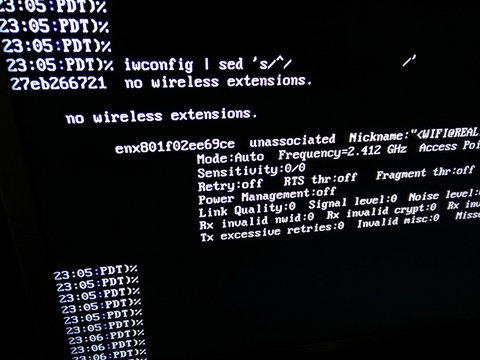
(I had the RPi plugged into my TV)
I do know about predictable network interface names, which is supposed to prevent interface names changing when hardware is swapped, among other things. The enx$MAC naming scheme is used for USB devices. Up until now I've been content to disable this feature by adding net.ifnames=0 to the kernel command-line. Indeed, I had this flag in /boot/cmdline.txt on the Pis but it just isn't working anymore.
It turns out that this feature is set to be deprecated in Debian 10, along with the automatically-generated /etc/udev/rules.d/70-persistent-net.rules file, which is appended when a new NIC is added to the system. This is documented in /usr/share/doc/udev/README.Debian.gz, apparently.
Unfortunately for me, the RPis never had 70-persistent-net.rules written and apparently udev 229-5 already ignores net.ifnames=0. One of my dist-upgrades bumped udev from 229-4 to 229-5. This is why none of the interface names that were defined in /etc/network/interfaces were found on boot and the RPis booted up with no enabled interfaces.
/usr/share/doc/udev/README.Debian.gz goes on to say that if custom interface names are needed, use 76-netnames.rules with the following content, which looks similar to what was previously written out in 70-persistent-net.rules automatically:
SUBSYSTEM=="net", ACTION=="add", ATTR{address}=="00:50:56:1a:aa:ab", NAME="eth0"There's no mention of this method of interface naming being deprecated so I'm going to use it for now.
This is just the latest annoyance, for me, when it comes to Linux's interface naming. Several years back the right way to setup predictable interface names was to use /etc/iftab and ifrename(8)!
What I haven't figured out is how this is going to impact VMs and virtio. My own VMs with VirtualBox have static MAC addresses assigned to the vbox file so using 76-netnames.rules will work fine. However, I'm not sure if EC2 and other Xen-based VPS providers always provide a constant MAC address. One of my EC2 instances has 53-ec2-network-interfaces.rules, which handles some sort of hotplugging. I'm not sure if that script will stop working as well after some time and udev upgrades but it would seem the solution is to use some ATTR other than 'addresss'.
About two weeks ago I picked up a GSM variant of the Galaxy Nexus smartphone. I decided that after almost two years with my Nexus One, it was time for an upgrade.
I've been running the Nexus One with CyanogenMod since mid-2010. As such, I've gotten used to the built-in BusyBox, enhanced power widget, status bar tweaks, OpenVPN functionality, and general hacker-friendly operation. I was hesitant to grab the Galaxy Nexus, which ships with Android 4.0 (codenamed Ice Cream Sandwich) until CyanogenMod 9, but I ended up ordering it anyway. Hopefully CM 9 will be out soon, but I'm not going to ask when!
If you're unfamiliar with the Nexus product line, it's a collection of Android devices (currently just phones) that run vanilla versions of Android. No carrier modifications or garbage are present, just plain Android. Unfortunately, a number of other Samsung devices sport names similar to the Galaxy Nexus, but should not be confused with it. Here's a list of Nexus devices, that are pure vanilla Android:
Here's a list of the non-Nexus devices that may be confused:
Observations
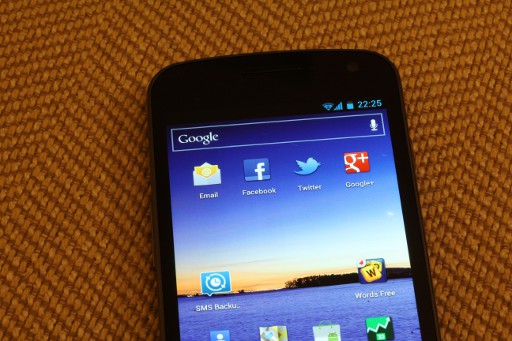
The Galaxy Nexus is a large phone with a 4.6" (diagonal) screen at 720x1280 pixels. The screen itself is very sharp and clear, although sometimes with a white background some bands are visible. I can't tell if this is a manufacturing defect or not.
Unlike the Nexus One, the Galaxy Nexus has the sleep button on the side and lacks a ball. The only way to physically wake the phone is to hit this button, unlike on the Nexus One where it can be configured to wake on both sleep button and ball depress. I'm slightly worried that the singular sleep button might wear out over time, but perhaps I'm being overly paranoid.
Android 4.0 seems like a nice upgrade from the 2.3.x series. I've never used an Android tablet with 3.x so I'm not sure how many 4.0 features first appeared in that version. The user interface is GPU-accelerated and provides smooth transitions through menus, although after a few minutes I disabled all the animations in the hopes of maximizing battery life. The 4.0.1 version I'm running uses Linux 3.0.1:
root@android:/sdcard # uname -a Linux localhost 3.0.1-ga052f63 #1 SMP PREEMPT Mon Nov 21 16:05:10 PST 2011 armv7l GNU/LinuxThe voice recognition is vastly improved over previous Android versions, although I don't use it all that often. In Android 2.3.x, the voice recognition would require the user to speak a few words and those would be sent to Google and returned in text form at once. In 4.0, instead of buffering the whole phrase, apparently the audio samples are streamed live to Google, which results in recognized words appearing on the screen almost as they're said. In other words, there appears to be no limit to the amount of words that can be recognized at once. Very cool, if you don't mind the extra data being chewed up by such things.
The GN has soft buttons instead of hardware buttons like on the Nexus One. These are nice because I can finally buy a pair of those touchscreen-friendly gloves and have them work! The Nexus One's hard buttons wouldn't ever work with those gloves, for some reason.
The photo gallery now automatically synchronizes Picasa albums, which struck me as a little odd when I first opened it. It's obvious that Google is trying to integrate Google+ more tightly with all aspects of Android. My contacts initially included all of my Google+ contacts, too, until I disabled that (I typically have no desire to call or e-mail the majority of my Google+ contacts).
The GSM variant of the Galaxy Nexus supports all GSM and UMTS frequencies used throughout the globe. This means that it can be used with any GSM carrier without the risk of things like HSPA+ not working. This makes the phone compatible with both AT&T and T-Mobile work out of the box.
The dual-core OMAP processor is interesting. Interesting as in only one core is active most of the time, with the second core only being used under high load or other situations. Perhaps this is the norm for dual-core CPUs in mobile devices, as it's an obvious way of extending battery life. Here's /proc/cpuinfo under normal situations:
root@android:/sdcard # cat /proc/cpuinfo Processor : ARMv7 Processor rev 10 (v7l) processor : 0 BogoMIPS : 597.12 processor : 1 BogoMIPS : 597.12 Features : swp half thumb fastmult vfp edsp thumbee neon vfpv3 CPU implementer : 0x41 CPU architecture: 7 CPU variant : 0x2 CPU part : 0xc09 CPU revision : 10 Hardware : Tuna Revision : 0009 Serial : 01298fc30100203fUnder high load the bogoMIPS increases to 2047. I've seen both cores listed in /proc/cpuinfo in the past, but when writing this I was unable to trigger activation of both cores. Anyway, we can see this from the kernel log:
root@android:/sdcard # dmesg|grep CPU|tail <6>[111361.896057] Enabling non-boot CPUs ... <4>[111361.912170] CPU1: Booted secondary processor <6>[111361.913208] CPU1 is up <6>[111361.917938] Switched to NOHz mode on CPU #1 <4>[111362.918182] Disabling non-boot CPUs ... <5>[111362.918823] CPU1: shutdown <6>[111363.056030] Enabling non-boot CPUs ... <4>[111363.072174] CPU1: Booted secondary processor <6>[111363.073211] CPU1 is up <6>[111363.078124] Switched to NOHz mode on CPU #1Speaking about CPUs, the developer options offer a nifty CPU utilization overlay graph to see what applications are hogging it:
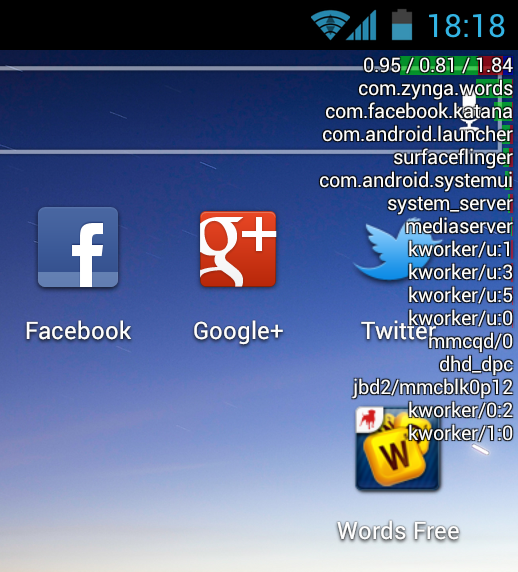
Since it can be seen here, I'll point out that Zynga's craptacular development of Words With Friends still causes it to chew up 100% of a single core when running. I suspect this is due to polling things that should be event or interrupt-driven instead. The game is so addicting, though!
Annoyances
Unfortunately, there are a few things about the Galaxy Nexus that are annoying.
Let's start with the hardware: the phone is just too large. Or, maybe my hands are just too small! While holding the phone, I have trouble reaching my thumb up to the top left portion of the screen. At first this was just an annoyance, however after using the phone for 15-20 minutes my arm started hurting from the strain. The large size combined with its thin and somewhat slippery frame makes it easy to drop. I've had a few close calls already while using the phone outside with one hand.
The sleep button should be on the top of the phone, not on the side. I don't use a case or belt clip for the phone and usually put it in my pants pocket. Unfortunately I find myself accidentally hitting the sleep button when putting it into my pocket, which results in a few incorrectly dialed emergency numbers or screen unlock attempts.
The GN wouldn't connect to my 5 GHz SSID at home. I've got my Cisco 1142 WAP configured for 802.11a and 802.11n, but the GN wouldn't see it at all, whether the SSID was broadcast or not! More research is needed, but this was a let down.
The screenshot feature that's built into Android 4.0 is a little weird. Why didn't they just add it to the power menu (hold sleep) like CyanogenMod 7.x did? It's annoying to have to hold volume down and sleep.
A huge annoyance with Android 4.0 was that it automatically signed me into Google Talk without notifying me (I never use Google Talk). I only figured this out because I saw myself online from my other XMPP account. It was easy to disable, but this should not by on by default.
The SMS emoticon icons are really ugly:
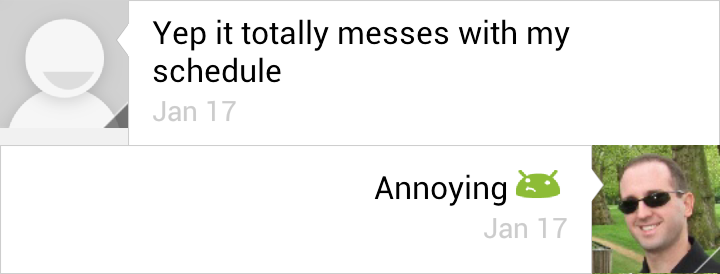
In general, things crash frequently. I don't think I have bad hardware (RAM, etc.) because I've heard similar reports from other GN (LTE variants) users. Applications crash and the phone has hard locked twice. It's annoying that there's no watchdog that automatically reboots or some way to trigger a hard reboot via the sleep button. So, in the case of a hard lock, removing the back case and battery is required. Also, the back case seems flimsy and cheap. I feel like I'm going to break it half the time.
The AT&T Debacle
I've had AT&T as my wireless carrier since sometime in 2007. I've moved the same SIM card between over half a dozen different phones without any issue and mostly kept the same plan. Since the Galaxy Nexus supports all five UMTS frequencies, I figured I wouldn't have a problem using HSPA+ on AT&T and getting some extra speed over my Nexus One. Unfortunately, this didn't work out.
After using the phone for the first week, I didn't notice any increased speeds. The Ookla mobile speed test application returned plain old congested HSPA speeds (1.7 Mbps downstream, and < 1 Mbps upstream), although latency seemed to be improved (39 ms RTT). I was puzzled since the network type indicated HSPA+:
root@android:/sdcard # getprop gsm.network.type HSPA:11After searching around I came upon this article that basically convinced me to leave AT&T. Essentially, AT&T won't grant customers access to the enhanced backhaul that traditionally accompanies the HSPA+ connection unless they're equipped with a 4G data plan (no price difference). Unfortunately, the only way to get a 4G data plan is to have an AT&T-supported device (ie, device sold by them). Obviously, an unlocked GSM Galaxy Nexus wasn't one of these devices and lying about this to customer service wasn't going to do any good because the IMEI won't be accepted.
Some folks claim they've gotten the AT&T employees to temporarily associate an IMEI from one of the in-store phones with their account to activate the 4G data plan, then switch it right back. I didn't go down this road not because I didn't think I couldn't finagle myself a 4G plan but because I don't agree with such a policy in the first place. I decided to switch to T-Mobile, and it was the best decision I've made in awhile.
The very next day I strolled into the local T-Mobile store and picked up a SIM card with the $60/month unlimited everything plan. After 2 GiB T-Mobile will cap me to EDGE speeds, but that's fine. I ported my number from AT&T and haven't looked back. The HSPA+ speed is blazing at night and not too bad during the day. The best I've gotten so far is 8 Mbps downstream and 1.7 Mbps upstream. Coverage at my condo is excellent and at work it's decent, too. Overall, it's slightly worse than AT&T but that hasn't bothered me, yet. What's a little strange is T-Mobile's internal IPv4 addressing scheme: they use pieces of 22/8 and 25/8 for mobile clients! I guess they don't have much public space to speak of and RFC 1918 can only go so far.
I also signed up for the T-Mobile IPv6 trial, which seems to work great. I think it'll work with any phone that sports an IPv6-enabled pppd, which aren't many, so far. The IPv6 trial is a separate APN that provides a single IPv6 address and DNS server (fd00:976a::9; it's whitelisted by Google over IPv6). IPv4 connectivity is provided by a NAT64 gateway alongside DNS64. The NAT64 prefix appears to be fd00:976a:c004:8fb1::/96 and the last 32 bits of this prefix directly map to an IPv4 address. Yes, these fd00 addresses are ULA, which makes sense so T-Mobile doesn't have to worry about their NAT64 gateway becoming accidentally public. I consistently get addresses out of the 2607:fb90:400::/40 prefix, and SSH seems to be allowed inbound! This makes copying files from my phone much easier when not on Wi-Fi. I have a feeling it won't last, though. Also, it's easy to switch back to the IPv4 APN with three taps, in case things go wrong. Two things that do not work on the IPv6 APN are MMS and applications that utilize ICMP.
Conclusions
The Galaxy Nexus is a great, albeit buggy, phone.. if you've got big hands and have T-Mobile. Otherwise, get the LTE version from Verizon Wireless and stay in the country. Android 4.0 has promise, if they can fix the bugs. Overall, I think everything software-related will be better when CyanogenMod 9.x is released!
I normally don't play around with such silliness, but this morning I figured I should try out the NAT64/DNS64 implementation by Ecdysis. NAT64 is a simple way for IPv6-only clients to access IPv4 systems. It's done with a combination of AAAA record synthesis and NAT. For a review of the IPv6 transition mechanisms, see my prior blog entry.
So, I downloaded and booted their Linux live CD (basically a modified Fedora disc) in VMware Workstation, and set it up to use 2001:48c8:1:12f::/96. It started Unbound and loaded nf_nat64 into the kernel with some address parameters. I then pointed a static route to the VM and injected 2001:48c8:1:12f::/64 (eh, not like I was going to use the rest of the /64 for anything else) into BGP. A couple DIGs verified that DNS64 was indeed working:
% dig @red slashdot.org. AAAA ; <<>> DiG 9.7.2-P3 <<>> @red slashdot.org. AAAA ; (2 servers found) ;; global options: +cmd ;; Got answer: ;; ->>HEADER<<- opcode: QUERY, status: NOERROR, id: 29892 ;; flags: qr rd ra; QUERY: 1, ANSWER: 1, AUTHORITY: 0, ADDITIONAL: 0 ;; QUESTION SECTION: ;slashdot.org. IN AAAA ;; ANSWER SECTION: slashdot.org. 3600 IN AAAA 2001:48c8:1:12f::d822:b52d ;; Query time: 733 msec ;; SERVER: 2001:48c8:1:105:250:56ff:fe1a:afaf#53(2001:48c8:1:105:250:56ff:fe1a:afaf) ;; WHEN: Sat Jan 1 12:15:13 2011 ;; MSG SIZE rcvd: 58Slashdot is, at first glance, a bad example, because one would think that being a tech. news site, they'd actually publish an official AAAA record and be accessible by IPv6. The truth is, they're even lagging behind CNN, so with such things, so the example is valid.
Anyway, it seems to work!
% telnet 2001:48c8:1:12f::d822:b52d 80 Trying 2001:48c8:1:12f::d822:b52d... Connected to 2001:48c8:1:12f::d822:b52d. Escape character is '^]'. HEAD / HTTP/1.1 Host: slashdot.org Connection: close HTTP/1.1 200 OK Server: Apache/1.3.42 (Unix) mod_perl/1.31 SLASH_LOG_DATA: shtml X-Powered-By: Slash 2.005001305 X-Fry: These new hands are great. I'm gonna break them in tonight. X-XRDS-Location: http://slashdot.org/slashdot.xrds Cache-Control: no-cache Pragma: no-cache Content-Type: text/html; charset=iso-8859-1 Content-Length: 146625 Date: Sat, 01 Jan 2011 17:17:27 GMT X-Varnish: 1317912096 1317911450 Age: 47 Connection: close Connection closed by foreign host.And after adding a default route to the Ecdysis VM and poking a few holes in my PF rules, NAT64 works off-net, too. The traceroutes are a little ridiculous, though:
core1.nyc1.he.net> traceroute ipv6 2001:48c8:1:12f::d822:b52d Tracing the route to IPv6 node from 1 to 30 hops 1 1 ms <1 ms <1 ms 2001:504:1::a502:9791:1 2 5 ms <1 ms <1 ms 0.ae1.tsr1.lga5.us.voxel.net [2001:48c8::822] 3 <1 ms <1 ms <1 ms 0.ae2.csr2.lga6.us.voxel.net [2001:48c8::82e] 4 <1 ms <1 ms <1 ms em0.dax.prolixium.net [2001:48c8:1:2::2] 5 34 ms 41 ms 33 ms si3.starfire.prolixium.net [2001:48c8:1:1ff::1a] 6 32 ms 36 ms 33 ms red.prolixium.com [2001:48c8:1:105:250:56ff:fe1a:afaf] 7 34 ms 40 ms 33 ms 2001:48c8:1:12f::a03:5fe 8 38 ms 42 ms 50 ms 2001:48c8:1:12f::a03:fd02 9 57 ms 50 ms 48 ms 2001:48c8:1:12f::ac9:4001 10 59 ms 56 ms 45 ms 2001:48c8:1:12f::184a:fe34 11 56 ms 50 ms 50 ms 2001:48c8:1:12f::185d:4017 12 55 ms 49 ms 54 ms 2001:48c8:1:12f::426d:652 13 56 ms 60 ms 52 ms 2001:48c8:1:12f::426d:6ab 14 58 ms 48 ms 50 ms 2001:48c8:1:12f::43b:c15 15 56 ms 49 ms 54 ms 2001:48c8:1:12f::445:9608 16 144 ms 50 ms 49 ms 2001:48c8:1:12f::d0aa:1751 17 56 ms 51 ms 55 ms 2001:48c8:1:12f::cc46:c802 18 110 ms 96 ms 89 ms 2001:48c8:1:12f::cc46:c4f2 19 87 ms 80 ms 92 ms 2001:48c8:1:12f::cc46:c37a 20 105 ms 87 ms 89 ms 2001:48c8:1:12f::4025:cfce 21 105 ms 88 ms 113 ms 2001:48c8:1:12f::401b:a0c6 22 106 ms 88 ms 87 ms 2001:48c8:1:12f::d822:b52dThe last 32 bits of the IPv6 address of each hop equates to the IPv4 address. For example, if you take hop 17 and translate it, something meaningful is displayed:
% ping -c1 0xcc46c802 PING 0xcc46c802 (204.70.200.2) 56(84) bytes of data. 64 bytes from 204.70.200.2: icmp_req=1 ttl=246 time=31.9 ms --- 0xcc46c802 ping statistics --- 1 packets transmitted, 1 received, 0% packet loss, time 0ms rtt min/avg/max/mdev = 31.946/31.946/31.946/0.000 ms % host 204.70.200.2 2.200.70.204.in-addr.arpa domain name pointer cr2-te-0-0-0-0.atlanta.savvis.net.After playing with this for awhile, it suddenly stopped working, though:
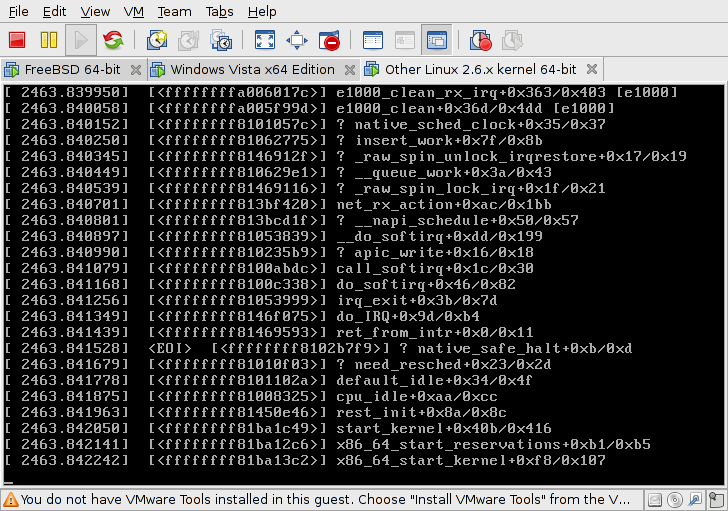
Oh well, they've got some bugs to fix in nf_nat64, I suppose.
Anyway, except for that panic, the Ecdysis software seems to work pretty well. It'll be nice once it starts to be included in the package systems of major Linux distributions.
Oh, and.. Happy New Year!
I'm finally sitting down to blog this, even though I'm being attacked by allergies, and losing the battle.
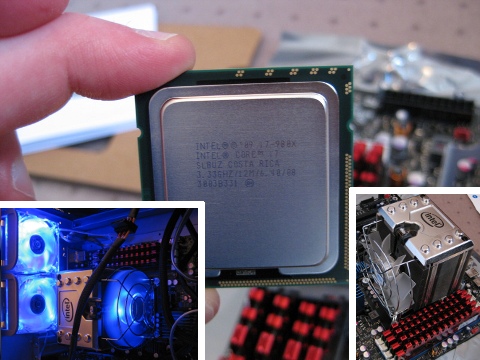
I recently upgraded my main workstation, destiny from an Intel Core 2 CPU to an Intel Core i7 CPU. Here are the specifications of the new (finished) upgrade:
- CPU: Intel Core i7-980X (6 core / 12 thread)
- Memory: 12GiB PC3-12800 DDR3-SDRAM (3x 4GiB G.SKILL pieces)
- Motherboard: Intel DX58SO
- Video: Gigabyte GeForce 9800 GT 1GiB
- Disk: OCZ Colossus 256GiB SSD
- Power Supply: Corsair 850Watt (did not buy this initially)
- ATSC Capture Card: DViCO FusionHDTV7 Dual Express
The only things remaining from my previous setup are an SB Live! PCI card (still sticking with it - it's about 10 years old, now), Antec case, and LG HD-DVD/Blu-ray burner.
I ordered all the parts on March 17, and only got everything working on April 6. Yeah, it was a little bumpy. Let's see if I can recount the whole process.
Order Placed
March 17. I ordered the Intel DX58SO and Core i7-980X CPU from ZipZoomFly since they gave me a combination deal, and I was weary of Newegg shipping me a fake CPU. It didn't ship until the 24th of March, though.
I ordered the video card, ATSC tuner, memory, and SSD from Newegg on the same day.
SSD Problems
My Newegg order arrived first, on the 23rd of March. Since I figured it wouldn't be a bad idea to try out some of the components, I threw the Gigabyte card into the current Core 2 system, replacing the cheap nVidia 7600 GS that I'd been using for the last three years. It fit nicely (took up two slots since it's fanless and has a huge heatsink). The HDMI and dual-link DVI-D output worked flawlessly, and Quake 4 seemed nice and smooth.
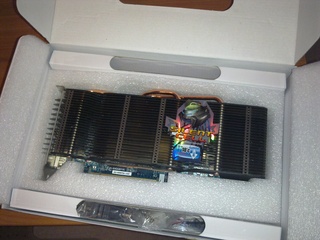
The next step was to take the current WD 160GB SATA disk and replace it with the new OCZ 256GiB SSD. I opened the package, and was greeted by a cheap box with no papers, manuals, warranty information, or anything. I also noticed that the QC date on the back of the SSD itself said 6.1.99. That can't be right, since SSDs of this size have only been around for the last year or so.
Anyway, I went to plug the drive into a spare SATA connector, when the plastic on the SATA connector on the drive broke! It snapped in such a way that the SATA cable refused to remain connected. Total crap. I sent it back to Newegg for a replacement.
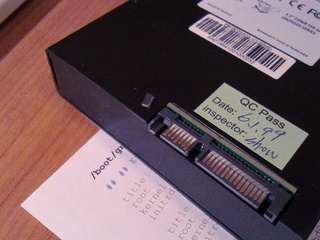
The ATSC card worked fine, though. It's much smaller than my previous one (DViCO FusionHDTV5 RT Gold) and has two tuners. I use it with a pair of bunny ears to grab 8VSB signals from Charlotte. Works great!
Motherboard/CPU/Memory Issues
The DX58SO motherboard and Core i7 CPU arrived from ZipZoomFly on the 31st of March. I put it all together, noting that the first RAM slots was black, compared to the rest, which were blue. The manual said that there were three channels, but channel A was shared between the first slot and the 2nd slot:
Installing memory in Channel A, DIMM 1 may result in less than optimal memory performance.
Well, that seemed annoying, but I kept all four of them in and installed the CPU. Strangely enough, the CPU heatsink and fan did not look like a standard stock Intel model. It looked more like a 3rd-party heatsink:
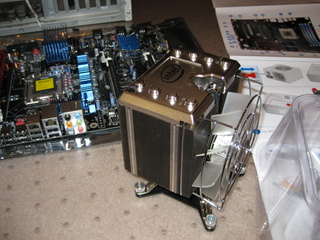
Even stranger, was the heatsink installation manual seemed to indicate that the fan on the heatsink should face the power supply. This made no sense whatsoever, so I faced the fan toward the front of the case, where it would blow air through the heatsink toward the rear. After checking online, this is what most people were doing, too. I finished installing everything (minus the SSD, it was still in Newegg RMA-land at the time). After connecting everything to my existing Thermaltake 550W power supply (more on this later), I pressed the power button!
Initially everything seemed to work. The first thing I did was upgrade the BIOS to 5112, since the 4xxx version that came with the board didn't officially support the 980X processor model. After rebooting after the BIOS upgrade I went back into the setup, loaded factory defaults by pressing F9 (remember this - it's important later on in the saga), set the SATA devices to AHCI, and disabled the onboard audio so I could use my SB Live! exclusively.
My Debian GNU/Linux (w/a custom 2.6.32 kernel) installation booted up just fine via a GRUB boot disk (for some reason I can't boot GRUB from the MBR on the disk on the new system and the old Core 2 system, which doesn't bother me too much since I try to never reboot) and X started up nice and fast. I started up some music, and did a couple small test encodes with HandBrake. The system seemed wicked-fast, and running properly!
About an hour into the testing (ie, playing) MPlayer crashed, and my music stopped. I forget the exact error I saw in the kernel log buffer, but it indicated that something had gone horribly wrong with sysfs. I thought that was really odd, but continued playing around. Quake 4 then started crashing, as did almost everything else. I then fired up 6-8 copies of burnP6 (part of the cpuburn package designed to stress-test certain chipsets and CPUs heavily) and the screen went completely blank. Something was obviously wrong.
I decided that maybe one of my memory sticks was bad. I decided to run memtest86, and see what was going on. Sure enough, tons of errors on what looked to be the 2nd chip, although I wasn't certain because I'm not sure how memory is interleaved lately:
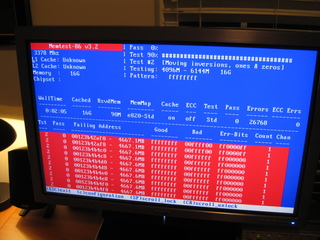
I ran memtest86 a few more times and got very inconsistent results. Some times it would show errors immediately, other times it would run for 30 minutes with no problems. I decided to go through the fun process of trying every stick by itself to narrow down the problem. I plugged in one stick and fired up 6 copies of burnP6, HandBrake in an infinite loop, and both my VMs (to use up the 4GiB) running. It had been a long day, so I hit the sack.
The next morning I find the system still running fine! RAM stick #1 was obviously working. I put in RAM stick #2 and let it run through until the next morning - worked fine, too. Unfortunately, the last two sticks checked out, too (I got lazy and only let them go for 3-4 hours each).
I stuck two sticks in (I think I used the first two slots, so they both went in channel A) and the system started to POST, then shut off! It did this a few times, then presented me with a BIOS error saying something like "the system has detected multiple POST failures" and prompted me to enter the BIOS setup. I poked around at memory settings, but really didn't know what I was doing, so I left it at default - autodetect.
I hunted around online, finding posts on Intel's site about DX58SOs dying easily, confirmed compatibility with the G.SKILL RAM modules (F3-12800CL9S-4GBRL) and the DX58SO, but didn't really find anything solid about the issue. I then ran into a few posts about instability issues caused by not enough power. I forgot that I was now running a pretty beefy CPU with decked-out RAM and a power-hungry video card. I went to Best Buy and picked out a Corsair 850 watt power supply.
After installing the new power supply, the system literally took TWO minutes to POST. Unfortunately, it seemed even more unstable than it did with the old power supply! So I threw the Thermaltake back in - and it did the same thing!
At this point it certainly seemed like something non-RAM was bad. I guessed the motherboard, and RMAed it.
Motherboard: Try two
I got the new motherboard from ZipZoomFly the same day I got my SSD back from Newegg (April 6). Were the stars aligning for a stable system? Well, maybe.
I threw everything together, but this time didn't populate the "black" RAM slot that would cause unoptimal performance (I learned this was roughly 5%, but I figured it may add to instability, too). Another TWO minute POST - and I got kernel panics at bootup during the USB device detection. Well, looks like the motherboard is good, but something else is bad.
I searched the G.SKILL forums and other places, and found recommendations to maximize RAM performance and overclocking recommendations, which I didn't want to do - I just wanted the system to work fine with the defaults (or baseline, etc). I began poking all around in the BIOS. In the "save changes" menu, I saw two options:
- Load Optimal Defaults
- Load Custom Defaults
Looking at these, I wondered what was custom defaults? Furthermore, I wondered what F9 actually did, since on the main screen that just said load defaults. After loading custom defaults, I noticed that not much had changed - actually I made a change to the onboard sound (enabled it), loaded custom defaults again, and it didn't change back. Odd. I don't know what made me do it, but I hit F9, then loaded custom defaults, then rebooted. Bam - everything worked - system was stable.
I ran a few benchmarks for a few hours, and it didn't budge.
Apparently the F9 key was actually an alias for optimal defaults, which was somehow overclocking the RAM in my system. Loading custom defaults on top of optimal defaults reset the RAM/CPU timings and clock speed back to normal. I found this strange, since with both defaults auto-detect was still enabled, but the greyed-out settings were notably different. Of course, none of these options were documented ANYWHERE in the manual. Thanks, Intel!
I installed the new SSD (which still had a QC date from 1999 - what the heck?), cloned the old WD 160GB to it, and was able to keep my old Debian installation.
Conclusion
I decided to not take the 5% memory hit, and returned the 4th stick of RAM to Newegg. Of course I think I'm going to get hit with the 15% restocking fee when they receive it, but worse things can happen.
To get the most out of the SSD, I disabled swap, and changed the journal mode on my ext3 filesystems to data=writeback. I suppose in a crash, I'll lose some data, but it won't be as bad as ext2.
As far as benchmarking, meh, since I don't have stuff like 3DMark on Linux, I can't really do it. Here are a couple of tests, though:
% glxgears Running synchronized to the vertical refresh. The framerate should be approximately the same as the monitor refresh rate. 100567 frames in 5.0 seconds = 20113.289 FPS 100770 frames in 5.0 seconds = 20153.916 FPS 100703 frames in 5.0 seconds = 20140.479 FPS 100628 frames in 5.0 seconds = 20125.492 FPS % sudo hdparm -t /dev/sda [sudo] password for prox: /dev/sda: Timing buffered disk reads: 696 MB in 3.01 seconds = 231.59 MB/sec % sudo hdparm -T /dev/sda /dev/sda: Timing cached reads: 18130 MB in 2.00 seconds = 9073.65 MB/secI also ran a few encodes from a Blu-ray source to H.264 resized to 720p. HandBrake averaged around 45-50fps. It seemed to use all 12 threads, but only at 50-60% each. Not sure why that happened, but 45fps is fine with me!

I took a boatload of photos during the build process.
I've been getting better at Quake 4, recently, now that it's finally smooth at 2560x1600 w/2x FSAA. Maybe I'll setup a server on dax, again…
The Core 2 guts will eventually move into my Windows 7 box, isis. I suspect I will have to reinstall Windows 7, in the process!
 Displaying page 1 of 3 of 24 results
Displaying page 1 of 3 of 24 results
Assistant Coach - XOS Product Marketing
TABLE OF CONTENTS
2007-08 USF Men’s Basketball - A New Era
BIG EAST Conference 2
NBA Draft - Solomon Jones 3
Strength/Sports Medicine 4
Community Service 5
Media Exposure 6
Summer Camps & Future Bulls 7
Sun Dome 8-9
Scholarship Endowments 10
Season Preview 11-14
Coaching & Support Staff
Head Coach Stan Heath 16-19
Asst. Coach Dan Hipsher 20
Asst. Coach Reggie Hanson 21
Asst. Coach Byron Samuels 22
Dir. of Operations Tommy Tonelli 23
Adm. Asst./Vid. Coord. Jamie Angeli 24
Senior Associate AD Barry Clements 25
Support Staff 26
Roster/Player Biographies
Numerical/Alphabetical Roster 28
TV/Radio Roster 29
Kentrell Gransberry 30-31
Mohamed Esseghir 32
Eddie Lovett 33
Mobolaji “BJ” Ajayi 34
Jesus Verdejo 35
Aris Williams 36
Solomon Bozeman 37
Chris Howard 38
Adamu “Amu” Saaka 39
Orane Chin 40
Dante Curry 41
Aaron Holmes 42
Dominique Jones 43
adidas 44
The 2007-08 University of South Florida Men’s Basketball Media Guide is
a publication of the USF Sports Information Office. Editor: Jeff Wuerth.
Contributors: Scott Kuykendall, Karlos Tellez, Chris Freet and Amy
Woodruff. Printer/Consultant — Rinaldi Printing/Steve Kimbler
Opponents
Cleveland State 46
Buffalo 46
Rhode Island 46
Florida Atlantic 46
Florida State 46
East Carolina 46
Florida International 47
UCF 47
Richmond 47
UAB 47
Wake Forest 47
St. Francis (NY) 47
Winston-Salem State 48
Rutgers 48
Syracuse 48
Pittsburgh 48
Providence 48
Seton Hall 48
West Virginia 49
Louisville 49
Marquette 49
St. John’s 49
Georgetown 49
DePaul 49
Connecticut 50
Cincinnati 50
Villanova 50
Notre Dame 50
2006-07 In Review
Final USF Statistics 52
Final Results 53
Game-By-Game Team Statistics 54
Game-By-Game Rebounding 55
Game-By-Game Scoring 55
Game-By-Game Starters 55
USF Leaders 56
2006-07 Box Scores &
Summaries 57-66
1
Program History & Records
Career Leaders 68-69
Season Leaders 70-71
Individual Game Records 72-74
Team Records 75-76
Annual Leaders 77-78
Charlie Bradley 79
Chucky Atkins 80
Radenko Dobras 81
Bulls in the NBA/Draft History 82
Program Honors 83
League Stat Leaders 84
1,000-Point Scorers 85-92
Letterwinners 93-94
Year-By-Year Stats 95-100
All-Time Opponents 101-104
Year-By-Year Results 105-113
League Standings/All-Time Coaches 114-116
Ranked Opponent History 117
Overtime History & 100-point games118
Tournament History 119-120
In Memory Of... 121
Embassy Suites 122
Media Information
Sports Information Staff 124-125
Media Outlets 126
Radio/TV Networks 127
Sports Information Contacts 128
The University
USF 130-131
City of Tampa 132-133
University President 134
Director of Athletics 135
Academic Services 136-137
Bulls Club 138
Sports Medicine 139
Strength & Conditioning 140
Cover designs — Karlos Tellez
Photography — Gary Dineen, J. Meric, Thomas Wagner, Greg Owen,
Brett Hansbauer, Kent Horner/NBAE/Getty Images, Scott
Cunningham/NBAE/Getty Images, Michael Okoniewski and Gary Shook.
1
BIG EAST CONFERENCE
2007-08 USF Men’s Basketball - A New Era
2
2
SOLOMON JONES - 2006 NBA DRAFT
2007-08 USF Men’s Basketball - A New Era
Solomon Jones
33rd Selection - Atlanta Hawks
Highest Draft Pick In USF History
3
3
STRENGTH & CONDITIONING - SPORTS MEDICINE
2007-08 USF Men’s Basketball - A New Era
4
4
Strength & Conditioning
USF student-athletes utilize one of the top weight
rooms in the country. The highly-respected staff
develops sport-specific programs with the goal of
maximizing the athletic potential of all Bulls.
Assistant Strength and Conditioning Coach Aaron
Komarek works directly with the men’s basketball
team.
Sports Medicine
USF Sports Medicine is proud to partner with the
best physicians and health care providers in the
Tampa Bay Area to be ready for any medical need
that arises. Looking ahead, USF plans to continue
to be recognized as a leader in both clinical sports
medicine and research in several areas. Assistant
Athletic Trainer Jen Ross works with men’s hoops.
COMMUNITY SERVICE
2007-08 USF Men’s Basketball - A New Era
Community Service
The USF men’s basketball team participates in
numerous community service projects throughout the
course of the year, both as a team and on an individual
basis. USF players make frequent stops at area
schools for speaking engagements and can often be
found on campus participating in organized activities
away from the basketball court. For more information
on requesting help from the USF men’s basketball
program, please call 813-974-3252.
5
5
MEDIA EXPOSURE
2007-08 USF Men’s Basketball - A New Era
6
6
Bulls In The Media
As a member of the powerful BIG EAST Conference,
USF enjoys exposure at a national level that few
schools can rival. Thanks to a new television package
with ESPN and a local television package with
Bright House Networks, the Bulls will see nearly all of
their regular season games carried on television. The
program already enjoys an impressive television
presence as one of 45-plus ISP Inc. universities in
the nation. Each of the team’s games are also carried
via the USF Radio Network and can be heard worldwide
thanks to www.GoUSFBulls.com. Based in the
12th-largest media market in the United States, Bulls
players have been able to make a name for themselves
on the court.
STAN HEATH CAMPS & FUTURE BULLS PROGRAM
2007-08 USF Men’s Basketball - A New Era
CAMPS
University of South Florida head coach Stan Heath and his staff will conduct their
annual Bulls summer basketball camps beginning in June.
There will be individual day camps, elite camp, and team camp available for kids
and teams of all ages. Each camper will be exposed to the fundamentals of basketball
and team play. They will receive well organized instruction from a camp
staff that is positive and enthusiastic. Also on hand to work with the campers will
be team members of the USF Bulls. All the action and excitement will take place
in the USF Sun Dome and Corral gymnasium. Each camp will provide an outstanding
environment in which to learn the game of basketball and improve individual
skills. Daily fundamental instruction, contests, shooting competitions,
guest speakers, and team play will highlight each day. Team camp will include
numerous games culminating with a bracketed elimination tournament.
For additional camp information or to register please call the USF Men's
Basketball Office at (813) 974-3252.
7
FUTURE BULLS
USF head coach Stan Heath has introduced the formation of Stan
Heath's Future Bulls Basketball Program and League.
The program will address team play, the proper attitude on and off the
court, academic responsibility, a drug and gang-free lifestyle, and respect
for parents and elders. The Future Bulls Basketball League (FBBL) is a
boy's league for grades 4-6 and 7-8, playing in two separate leagues. The
youth in the league will be coached by current USF players and play a
10-game schedule.
The program and league includes numerous other benefits and is only
$150 per participant. Listed below are the benefits for being a member:
Official adidas Future Bulls Basketball League (FBBL) Game Jersey;
Opportunity to be drafted and coached by a USF Bulls Basketball Player;
Compete in a 10-game schedule against other Future Bulls; Only than
eight to nine players on each team; Free admission and introduction at a
USF Bulls home men's basketball game; Personally autographed photos
of your favorite Bulls' players; Opportunity to view and purchase Official
FBBL DVD featuring league highlights, interviews and special messages
from USF Basketball; Access to "Members Only" area of the Future Bulls
website and Future Bulls "Books and Ball" e-newsletter.
"The Future Bulls Basketball Program is so much more than just a basketball
league," said Heath. "It is an opportunity for our USF men's basketball
program to impact the community in a very significant manner.
Each Future Bull will have the chance to interact with some of their
favorite basketball players at USF and in turn our players will be given the
opportunity to learn the importance of being a positive role model for our
area's youth."
For more information or a program brochure call the men's basketball
office at 813-974-3252. You may also visit the website at www.futurebulls.com
for online information and registration. The program will take
the first 180 members to sign up and will run from Nov. 11 to Feb. 24.
7
SUN DOME
2007-08 USF Men’s Basketball - A New Era
Nearly 50 universities granted R.
Buckminster Fuller, one of the 20th century’s
greatest thinkers, an honorary degree during
his life. The University of South Florida was
not among them.
But USF has, unknowingly, created a tribute
to Fuller, the man who was a scientist, a
philosopher, an inventor, a designer, the man
who coined the term “Spaceship Earth.”
Fuller was also the creator of the geodesic
dome — an architectural design based
upon his discovery that a triangle withstands
pressure better and is twice as strong as a
rectangle. He discovered that if a spherical
structure was created from triangles, it would
have unparalleled strength.
The USF Sun Dome, a 10,411-seat facility
that is home to USF basketball, has taken one
of Fuller’s most outstanding legacies and,
over a six-month period in 2000, reinvented
itself.
Built at a cost of $12 million between 1977
and 1980, the USF Sun Dome on the campus
of the University of South Florida opened its
doors in December, 1980.
The unique building design featured an
air-supported roof made from a 90,000square-foot
translucent teflon-coated fiberglass
fabric.
An $8 million construction project utilizing
Fuller’s design principles has recreated
the USF Sun Dome and has allowed the 27year-old
facility to assume a prominent role
8
The most recent improvements to the Sun
Dome included nearly $2 million in high-definition
scoreboards and a new playing surface.
in entertaining Tampa Bay and the entire central
Florida region.
The centerpiece of the project is a steelframe
geodesic dome roof constructed from
more than 3,000 beams and weighing more
than 400 tons.
The 2005-06 campaign debuted the facility’s
latest round of upgrades. High-definition
video scoreboards were placed in each of the
arena’s four corners in time for the inaugural
BIG EAST season.
The men’s and women’s basketball teams
also enjoyed the installation of a new playing
surface in 2005. The QuickLock Portable
Floor is made of northern hard maple and
contains red power shok pads attached. The
graphics feature the “USF” logo at mid-court
and BIG EAST logos in the lane at both ends
of the court.
Renovation of the USF Sun Dome’s interior
has also included restrooms, dressing
rooms, locker rooms and office space.
Features also include a $250,000 lighting system
and a new audio system.
The USF Sun Dome is managed by Sun
Dome Inc., a not-for-profit corporation.
Beers Construction of Tampa was the primary
contractor for the project.
The USF Sun Dome has hosted six NIT
games as well as an NCAA sub-regional in
1983 with Arkansas, Illinois State, Kentucky,
Ohio, Purdue, and Robert Morris.
8
All-Time Attendance
Home
1971-72: 23,145
1972-73: 27,024
1973-74: 23,705
1974-75: 32,247
1975-76: 37,406
1976-77: 20,198
1977-78: 24,476
1978-79: 16,049
1979-80: 18,703
1980-81: 90,814
1981-82: 63,716
1982-83: 90,670
1983-84: 74,774
1984-85: 86,208
1985-86: 39,094
1986-87: 48,841
1987-88: 71,720
1988-89: 81,817
1989-90: 71,536
1990-91: 104,958
1991-92: 100,576
1992-93: 74,936
1993-94: 61,670
1994-95: 77,704
1995-96: 73,318
1996-97: 70,564
1997-98: 65,124
1998-99: 62,241
1999-00: 62,333
2000-01: 67,066
2001-02: 77,959
2002-03: 60,677
2003-04: 50,214
2004-05: 41,871
2005-06: 58,288
2006-07: 58,499
Away
1971-72: 39,147
1972-73: 41,114
1973-74: 36,482
1974-75: 51,159
1975-76: 42,465
1976-77: 94,168
1977-78: 47,394
1978-79: 63,747
1979-80: 36,236
1980-81: 58,690
1981-82: 39,168
1982-83: 93,421
1983-84: 51,856
1984-85: 71,716
1985-86: 62,428
1986-87: 76,554
1987-88: 90,339
1988-89: 47,832
1989-90: 51,651
1990-91: 46,949
1991-92: 74,153
1992-93: 58,892
1993-94: 74,898
1994-95: 63,156
1995-96: 81,523
1996-97: 64,043
1997-98: 64,568
1998-99: 77,711
1999-00: 89,743
2000-01: 94,222
2001-02: 80,678
2002-03: 101,411
2003-04: 89,668
2004-05: 99,110
2005-06: 103,338
2006-07: 134,301
SUN DOME
2007-08 USF Men’s Basketball - A New Era
Sun Dome Records
Individual - USF
Points: 38, Charlie Bradley (Florida 1/11/83)
FG Attempts: 31, Charlie Bradley (Florida 1/11/83)
FG Made: 17, B.B. Waldon (TCU 1/5/02)
FG Pct: 1.000 (8-8), Jesse Salters (FAU 12/3/93)
3-pt Attempts: 16, Melvin Buckley (Stetson 11/27/06)
3-pt Goals Made: 8, Radenko Dobras (Florida 1/9/89)
FT Attempts: 18, Charlie Bradley (Penn State 12/20/82)
FT Made: 15, Solomon Bozeman (Stetson 11/27/06)
FT Pct: 1.000, Charlie Bradley (11-11) (Florida 12/4/84)
Derrick Sharp (10-10) (NE Illinois 12/27/91)
Rebounds: 24, Darrell Coleman (Miami 3/1/88)
Assists: 12, Tommy Tonelli (Florida A&M 12/7/84)
Arthur Caldwell (Cincinnati 12/17/86)
Arthur Caldwell (VCU 1/24/87)
Reggie Kohn (Cincinnati 1/26/02)
Chris Capko (Jacksonville 11/25/05)
Steals: 10, Altron Jackson (Florida St. 1/2/02)
Blocks: 11, Gerrick Morris (G. Washington 11/28/00)
Individual - Opponent
Points: 39, Craig Beard (Samford 12/29/82)
FG Attempts: 27, Frank Ross (American vs. VT 12/28/85)
FG Made: 17, Ken Lyons (N. Texas St. vs. Samford 12/28/82)
FG Pct: 1.000 (8-8), Chris Crawford (Marquette 1/30/97)
3-pt Attempts: 16, Deonta Vaughn (Cincinnati, 1/14/07)
3-pt Goals Made: 6, Dave Buckner (Fordham 3/14/91)
6, Kenny Harris (VCU 2/20/93)
6, Kenny Harris (VCU 2/20/94)
6, Junior Blount (TCU 1/5/02)
6, Colin Falls (Notre Dame 2/3/07)
3-pt Percentage: 1.000 (6-6), Kenny Harris (VCU 3/5/94)
FT Attempts: 18, Dan Montgomery (Roosevelt 12/22/82)
FT Made: 13, Dan Montgomery (Roosevelt 12/22/82)
FT Pct: 1.000, Bernard Royster (9-9) (ODU 1/3/87)
Wesley Matthews (8-8) (Marquette 1/28/07)
Andy Kennedy (8-8) (UAB 1/8/90)
Terry Rupp (8-8) (Tampa 12/3/86)
Rebounds: 20, Chris Gatling (Old Dominion 2/7/90)
Assists: 15, Jerry Hobbie (Fordham vs. LaSalle 12/28/84)
Blocks: 12, Cedric Lewis (Maryland 1/19/91)
Sun Dome Quick Facts
Built: 1977-80
Opened: November 29, 1980
First Game: November 29, 1980 vs. Florida A&M
Dedication Game: December 2, 1980 vs. Duke
First Win: Dec. 6, 1980 vs. UNC-Greensboro
50th win: Jan. 15, 1984 vs. Jacksonville
100th win: Jan. 6, 1990 vs. Miami
150th win: Dec. 30, 1994 vs. Hartford
200th win: Nov. 28, 2000 vs. George Washington
250th win: March 4, 2006 vs. Georgetown
Initial Cost: $12 million
Renovation Cost: $8 million (2006)
Capacity: 10,411
All-Time Record: 259-142 (.646)
Media Room Telephone: 813-974-3752
Press Row Telephone: 813-974-3287
9
Team - USF
Points: 117, Roosevelt (12/22/82), TCU (1/5/02)
Points, One Half: 64, TCU (1/5/02)
Margin of Victory: 44, Roosevelt (12/22/82)
Fewest Points: 36, Marquette (1/30/97)
Fewest Points, Half: 16, St. Peters (12/4/85)
Highest Two-Team Total: 225, USF 117-TCU 108 (1/5/02)
Lowest Two-Team Total: 79, USF 45-St. Peters 34 (12/4/85)
FG Attempts: 89, Roosevelt (12/20/80)
FG Made: 46, Roosevelt (12/20/80)
FG Percentage: 64.3 (36-56), Florida A&M (12/7/84)
3-pt Attempts: 28, Michigan State (12/20/97)
3-pt Goals Made: 10, Florida (1/9/89)
FT Attempts: 53, NE Illinois (12/27/91)
FT Made: 42, NE Illinois (12/27/91)
FT Percentage: 94.4 (17-18), South Alabama (2/9/91)
Rebounds: 65, Long Island (12/30/95)
Personal Fouls: 32, Memphis (2/7/01)
Single Game Attendance: 10,444, Florida (12/8/01)
Team - Opponents
Points: 100, Memphis (2/7/01)
Fewest Points: 34, St. Peters (12/4/85)
Fewest Points, One Half: 8, Oglethorpe (1/16/81)
Field Goal Attempts: 79, Xavier (1/26/91)
American vs. Va. Tech (12/28/85)
FG Made: 42, Michigan (12/29/87)
FG Pct: 66.7 (30-45), Va. Commonwealth (3/5/94)
3-pt Attempts: 31, Western Kentucky (1/12/91)
3-pt Goals Made: 14, TCU (1/5/02)
3-pt Percentage: 81.8 (9-11), Fordham (3/14/91)
FT Attempts: 43, Virginia Tech vs. American (12/28/85)
FT Made: 35, Tampa (12/3/86)
FT Percentage: 1.000 (14-14), Houston (12/29/89)
Rebounds: 63, Clemson vs. Fla. International (12/29/87)
Personal Fouls: 34, NE Illinois (12/27/91)
NOTE: Sun Dome records begin on November 29, 1980.
Current players in bold
All-Time Sun Dome Record
Season Won Lost PCT
1980-81 15 3 .833
1981-82 13 2 .867
1982-83 15 3 .833
1983-84 12 4 .750
1984-85 12 6 .667
1985-86 10 4 .714
1986-87 6 7 .462
1987-88 4 11 .267
1988-89 7 9 .438
1989-90 13 3 .813
1990-91 13 4 .765
1991-92 12 2 .857
1992-93 6 8 .429
1993-94 8 4 .667
Season Won Lost PCT
1994-95 13 4 .765
1995-96 8 5 .615
1996-97 7 8 .467
1997-98 8 6 .571
1998-99 6 7 .461
1999-00 11 2 .846
2000-01 11 2 .846
2001-02 10 6 .625
2002-03 13 2 .867
2003-04 6 9 .400
2004-05 8 5 .615
2005-06 4 10 .286
2006-07 8 7 .533
27 Years 259 142 (.646)
9
ENDOWMENTS
2007-08 USF Men’s Basketball - A New Era
The Richard and Roslyn Wittcoff & Family
Endowed Scholarship
In 1982, Richard and Roslyn Wittcoff established the first of two endowments for
the men’s basketball program. Through the generosity of the Wittcoffs, this endowment
provides complete funding for one USF basketball player’s annual education.
Since 1987, the award has been annually presented in recognition of a graduating
senior. The honored player is selected by Richard Wittcoff in conjunction with the
men’s basketball coach.
Richard & Roslyn Wittcoff & Family Scholarship Honorees
1987-88 (Darrell Coleman), 1988-89 (Rob Anderson), 1989-90 (Hakim Shahid),
1990-91 (Tony Armstrong), 1991-92 (Fred Lewis and Gary Alexander), 1992-93
(Derrick Sharp), 1993-94 (Jesse Salters), 1994-95 (Jesse Salters), 1995-96
(Chucky Atkins), 1996-97 (James Harper), 1997-98 (Brian Lamb), 1998-99
(Shaddrick Jenkins), 1999-00 (Altron Jackson), 2000-01 (Cedric Smith), 2001-02
(B.B. Waldon), 2002-03 (Reggie Kohn), 2003-04 (Brian Swift), 2004-05 (Brian Swift),
2005-06 (James Holmes), 2006-07 (Kentrell Gransberry)
Richard & Roslyn Wittcoff Endowed Scholarship
In January, 1991, Richard & Roslyn Wittcoff generously added a second endowment
to the men’s basketball program. This endowment is awarded in recognition of a
USF men’s basketball player who exemplifies a commitment to the ideals of academics,
character and sportsmanship expected of USF basketball student-athletes. The
endowments the Wittcoffs have provided will permanently represent the University’s
competitive spirit and commitment to excellence in NCAA Division I basketball.
Richard & Roslyn Wittcoff Scholarship Honorees
1991-92 (Radenko Dobras and Bobby Russell), 1992-93 (Jesse Salters), 1993-94
(Vincent Hyatt), 1994-95 (Greg Summers), 1995-96 (Donzel Rush), 1996-97 (Brian
Lamb), 1997-98 (Brian Lamb), 1998-99 (Anddrikk Frazier), 1999-00 (B.B. Waldon),
2000-01 (Altron Jackson), 2001-02 (Altron Jackson), 2002-03 (Will McDonald), 2003-
04 (Gerrick Morris), 2004-05 (Bradley Mosley), 2005-06 (Solomon Jones), 2006-07
(McHugh Mattis)
Additional Men’s Basketball Endowments
Dow Sherwood Endowed Basketball Scholarship
Wittcoff Endowed Basketball Scholarship
Bill Jones Endowed Scholarship in Basketbal
Paul and Ann Givens Scholarship in Basketball
10
10
Richard and Roslyn Wittcoff
generously support USF basketball
with two endowments.
The Wittcoffs, Roslyn and Richard,
have been very supportive of the basketball
program over the last 25
years. In January 2004, Mrs. Wittcoff
passed away after battling an illness.
While the program has lost a valued
member, the wonderful spirit and
memory of Roslyn K. Wittcoff will live
on forever in the lives of the players
and coaches she touched.
Season Preview
SEASON PREVIEW
2007-08 USF Men’s Basketball - A New Era
With the arrival of first-year head
coach Stan Heath, the 2007-08 season
will be the start of a new era for
the University of South Florida men's
basketball program.
Heath will lead USF into its third
BIG EAST season after successful
coaching stints at Arkansas and Kent
State, which included three NCAA
Tournament appearances, a 30-win
season and an Elite 8 finish.
New Head Coach
Stan Heath
BULLS BY POSITION
Guards
Bozeman, Curry, Holmes*, Howard,
Jones, Lovett, Saaka*, Verdejo
Forwards
Ajayi, Chin, Esseghir, Holmes*,
Saaka*, Williams
Centers
Gransberry
* = listed at two positions
12
“This is a great basketball league
with outstanding coaching," said
Heath. "We're the new kids on the
block and we're trying to climb that
ladder. We're going to put in the work
just like everybody and we're going
to fight for a championship. We probably
have a long way to go to get
there, but we're still going to hunt
every time we get that opportunity to
step out on the court.
"We definitely want to
make the BIG EAST tournament,
and we definitely have
aspirations to fight our way
into some kind of postseason
play. We have to do a good
job in the non-conference
portion of our season and
then carry momentum into
our conference play. We
know right now we're not on
the radar screen in a lot of
people's minds, but we feel,
like every year, that there's an
opportunity for a surprise
team to open some doors and
we want to fight our way into
that kind of situation."
Leading the way for Bulls
will be senior center and preseason
All-BIG EAST selection
Kentrell Gransberry.
Gransberry, a 6-9, 270-pound
force in the middle, is the top
returning rebounder in the
country. The Baton Rouge,
La., native pulled down 11.4
boards per game last season,
tops in the BIG EAST and
third-best in the nation, averaged
15.6 points per game
and shot 57.7 percent from
the field in his first season in
Division I.
Gransberry, an All-BIG
EAST Second Team selection,
saved one of his best
performances for last, posting
career highs of 26 points and
23 rebounds at DePaul in the
final game of the season. The 23
rebounds were tied for second-most
in the country in a single game last
year and matched the second-best
single-game total in BIG EAST history.
It was the fourth-best single-game
rebound performance in USF history.
He also became just the fifth player in
USF history and ninth in BIG EAST
annals to notch a 20-point, 20-
Kentrell Gransberry
SEASON PREVIEW
2007-08 USF Men’s Basketball - A New Era
rebound game.
"We're very excited about having
a big man the caliber of Kentrell
Gransberry," said Heath. "On any
given night he's capable of posting a
double-double. Obviously teams are
going to give him a lot of attention so
it's important for our other guys to
contribute in different ways."
The big man will have some help
as the Bulls return six of their top
eight scorers, seven letterwinners
and three starters in Gransberry and
sophomore guards Chris Howard
and Solomon Bozeman.
Howard has battled a knee injury
for the past year and a half and
Chris Howard
missed the first 16 games of last season,
but the point guard returned to
start 13 of the final 14 games. He
wasted little time making his presence
felt, averaging 5.86 assists per
game in BIG EAST play, second-best
in the conference. Bozeman
appeared in all 30 games, starting
24, and was fourth on the team in
scoring at 9.6 points per game. He
was nearly automatic at the free
throw line, hitting 88 percent from the
charity stripe, second in the BIG
EAST and 16th in the country.
Bozeman also contributed 3.47
assists per game.
Junior guard Jesus Verdejo
became eligible in
mid-December
after transferring
from Arizona and
played in 22 games (14 starts),
including eight starts in conference
play. He averaged 7.0 points per
game. Also returning are junior forward
Aris Williams (10 games
played, two starts), sophomore G/F
Amu Saaka (29gp/2gs) and senior G
Eddie Lovett (26gp). Williams had
right knee surgery in January and
missed the entire conference portion
of the schedule.
The Bulls welcome six newcomers,
many who will be expected to
contribute immediately. The newcomers
consist of two true freshmen
(G Dominique Jones and F Orane
Chin), a redshirt freshman (G Dante
Curry), a redshirt freshman transfer
(G/F Aaron Holmes), a junior transfer
(F Mobolaji Ajayi) and a senior transfer
(C Mohamed Esseghir). Curry
ROSTER BREAKDOWN
Starters Returning
Kentrell Gransberry, C (15.6 ppg, 11.4 rpg)
Solomon Bozeman, G (9.6 ppg, 3.5 apg)
Chris Howard, G (5.6 ppg, 5.9 apg)
Others Returning
Jesus Verdejo, G (7.0 ppg, 2.0 aapg)
Aris Williams, F (3.5 ppg, 5.2 rpg)
Amu Saaka, G/F (3.5 ppg, 3.0 rpg)
Eddie Lovett, G (0.9 ppg, 0.5 rpg)
Starters Lost
Melvin Buckley (14.8 ppg., 4.9 rpg.)
McHugh Mattis (12.8 ppg., 7.2 rpg.)
Other Key Players Lost
Melvyn Richardson (2.1 ppg., 2.8 rpg.).
Chris Capko (1.8 ppg., 2.2 apg.).
Bulls By Class
Freshmen: Chin, Curry (RS), Holmes (RS), Jones
Sophomores: Bozeman, Howard, Saaka
Juniors: Ajayi, Verdejo, Williams
Seniors: Esseghir, Gransberry, Lovett
RS=Redshirt
13
SEASON PREVIEW
2007-08 USF Men’s Basketball - A New Era
missed last season due to an Achilles
tendon injury, while Curry transferred
from Florida State and will be eligible
in mid-December. The 6-9 Ajayi and
the 6-10 Esseghir will add much
needed depth to the front line.
Heath has also hired a top-notch
coaching staff that includes Dan
Hipsher, Reggie Hanson, Byron
Samuels, Tommy Tonelli and Jamie
Angeli. Molding everything together
is the task that Heath and his staff
have ahead of them.
"Right now we're instilling in our
team things that we feel are important,"
said Heath. "Things what I
would call our signature, our stamp.
We want to be a team that runs the
floor both offensively and defensive-
Solomon Bozeman
14
ly. We want to be a team that defends
very aggressively. We also want to
be a team that rebounds the ball at
both ends in order to start our running
game.
"And then the signature part, that
I think all good teams have, are very
strong fundamentals. Being able to
pass, shoot and make free throws.
We want to be a team that plays very
well together out there on the court."
Team chemistry is something
that has been evident since Heath
arrived on campus.
"I've been pleasantly pleased
with the character of the players on
our team," said Heath. "I really think
that there's a good foundation in
place with the guys returning. They
take care of business. They're
good in school. They're not in
any kind of off-court trouble.
They've done a great job of working
together. We're still in our
process of making it stronger, but
I do think the basics are in place
and we just want to build on
that."
Heath understands the challenge
ahead and feels the BIG
EAST and Tampa are the perfect
place to do it.
"I couldn't be more excited
about being in a place like
Tampa," said Heath. "I think it
has so much opportunity, a great
wealth of resources and talent in
the state. There's a buzz about
sports in this town and I really
believe that fans here get excited
about teams that win. We certainly
feel that we have a great
university to sell.
"We just feel like being in the
BIG EAST opens a lot of doors.
We feel like we can not only
recruit our state hard, but we can
reach out to other areas and
there's a strong interest from kids
who would not only love to come
to Tampa, but to play in the BIG
EAST as well."
ROSTER BREAKDOWN
Florida (5)
Curry, Esseghir, Holmes, Jones,
Lovett
Arkansas (1)
Bozeman
photoimpression 4.0 Free s
photo edit software for samsung mobile
= = = = = = = = = = = = = = = = = = = = = = = = = = = = = = = = = = = = = = = = =========> Download Link photo edit software for samsung mobile = = = = = = = = = = = = = = = = = = = = = = = = = = = = = = = = = = = = = = = =
Photo Editor For Samsung is a kind of Photography apps for Android, 9Apps official website provides download and walkthrough for Photo Editor For Samsung, Play free Photo Editor For Samsung online. Photo Editor is a small but powerful photo editing application. If you have some knowledge of photography, you can do a lot with Photo Editor. Now use Photo Editor to edit photos on your mobile phone just like you would on a PC. Features * Color : exposure, brightness, contrast, saturation, temperature, tint and hue Photo Editor- is an amazing all-in-one photo editor! With Photo Editor- you can enhance your photos, apply effects, add stickers, create collages, paint & draw, remove blemishes, whiten smiles and so much more!Here are some of the amazing features:• Enhance Photos in Seconds • Add Endless Stickers• Apply Amazing. 10 best photo editing apps for Android tablets. Edit your photos on your tablet! Adobe Photoshop Lightroom and Adobe Photoshop Express. AirBrush. Facetune. Fotor Photo Editor. PhotoDirector. Photofy Content Creation Tool. Photo Editor by Aviary. Photo Editor Pro. Want to take a good picture with Samsung Note 8?Read our tips to give you the options of best photo editing apps for Samsung Note 8,android devices. Along with basic photo tuning like brightness, contrast, and color, it provides a wide variety of photo-editing effects.. Photo Editor: More photo editing options.. Social Support. Contact us on Twitter or Facebook and we'll reply with an answer to your question or issue. alt1. /samsungsupport. alt2. @samsungsupport. Create and Edit a Video with Video Editor on Your Galaxy Camera. Using the Video Maker app on your Samsung Galaxy Camera, you can edit and create custom video compilations right on your camera. Version: 1.2.80 (128000000) arm. Package: com.sec.android.mimage.photoretouching 16,272 downloads. 22.25 MB (23,331,790 bytes). Min: Android 6.0 (Marshmallow, API 23). Target: Android 6.0 (Marshmallow, API 23). nodpi. MD5, SHA-1, SHA-256 signatures. Uploaded January 10, 2017 at 5:09PM. The best photo editing apps for Android and iOS. Google Snapseed. Price: free. Google Snapseed is a fantastic app that puts many desktop photo editors to shame with sheer amount of features that are packed inside. Adobe Photoshop Express. Price: free. Facetune. Price: £3.99/US$5.99/AU$5.99. Prisma. Price: free. VSCO.. If you're as snap-happy as other smartphone users, undoubtedly your phone is filled with thousands of photos and videos. But taking pictures is only half the fun; the best part is editing and then sharing them with friends and family — or complete strangers, for that matter. But what apps are best for making. Looking for the best photo editing apps that Android has to offer? Check out this selection to help you get your snaps looking their best! So on my iPhone I found a bunch of cool apps that added effects to my photos. The one I used the most was called WoWFX. Unfortunately its a apple only app. So I've been searching like crazy but can't find one thats even remotely similar. I have yet to find a single app that can add lightning or fire effects to. Once you take the photo, what do you do with it before sharing? You edit it!. And because Photos has unlimited storage, you can feel safe deleting pics from your phone to free up that space. Google.. Lightroom is the photo editing software from Adobe Creative Cloud, and now it's available on Android. Best Photo Apps for Android for 2018. Our editors hand-picked these products based on our tests and reviews. If you use our links to buy, we may get a commission. A comprehensive roundup of the best Photo Editing Apps for photographers and users of smartphones.. These might be apps that you use to control your camera at the point of capture (as opposed to using the vanilla camera app with which your phone came.. support.google.com/snapseed. There are many mobile photo editing apps available across all of the app stores, making it tough to choose which ones to use.. The Advanced Pack has options like noise reduction and DeFog (Windows Phone 8 and iOS only).. The Darkroom app also has infinite undo history and custom filter support. 5 min - Uploaded by PocketnowThe cameras on our smartphones are pretty great, and most of us use them to constantly take. If you want to give extra life to the photos you take with your smartphone camera, you need the right photo editing app. The applications available on Android and iOS. Check out this selection of five fine photo editors and try them out on your photos. We hope you end up pleased with what you create! Download this app from Microsoft Store for Windows 10 Mobile, Windows Phone 8.1, Windows Phone 8. See screenshots, read the latest customer reviews, and compare ratings for Photo Editor.. Installation Get this app while signed in to your Microsoft account and install on up to ten Windows 10 devices. Language. One of the gentlemen said he just directly Wifi'd to his cell a group of photos he took and showed me his best one.. You can do everything from taking a photo, to editing, creating your own stickers, drawing, texting on, creating collages and so much more.. Toptal: Hire the top 10 software developers. The support for raw data images is, of course, remarkable. Only the DNG and RW2 formats are used here. You can use any editing steps that are available on the desktop. Thanks to the integrated camera, you can also integrate mobile photography into your Lightroom workflow. The app syncs images with. Photo editing apps for phones can make your pics looks much better than straight out of the camera, but they need to be similarly convenient and easy to use. Here are our picks for the. Pixlr on mobile devices is also powerful, though it isn't a Photoshop replacement by any means. Like Snapseed, you. The fast way to deal with photo issues right on your phone is Adobe's Photoshop Express app, available for Android, iOS, and Windows. It's both the most powerful I've ever used and the simplest — quickly accomplishing things that you'd normally need paid software for. Here's a quick tour of its features. With a host of photo-editing apps for iOS and Android to choose from, we've rounded up some of the best that are worth your attention. Note: Just because it's free, there is no guarantee that a photo-editing app might not cost you down the line via in-app purchases. If you feel tempted by those, consider. When cell phone manufacturers began putting digital cameras into their devices some 15 years ago, a quantum leap occurred regarding the devices' overall functionality. Prior to this revolution, a cell phone's role in anyone's daily life consisted of merely making phone calls and sending text messages. Edit photos quickly and easily on your Android phone or tablet with these apps. From high-end image editors to quick-fix filters, here's our selection of iOS and Android apps to make your photos picture perfect.. Once upon a time the idea of editing photos on a phone or tablet was considered folly – akin to painting watercolours on a piece of sponge. But that all changed as screens got. MacOS, Windows, iOS, Android and online photo editing tools & free photo editors. Snapseed is a powerful photo editing app for your Android. While Android. While Android has basic photo editing software built into its Photos apps, Snapseed does everything better and has more features. View full. Snapseed's ease of use and feature set make it one of the best photo editing apps for mobile. The app is. Pocket Darkroom:The Best Mobile Photo Editing Apps. App stores abound. Snapseed's innovative and easy-to-use interface instantly made the app a favorite when Nik Software first launched the software for iPad in 2011.. Once you've got the hang of Snapseed, you'll wish every bit of software was so intuitive. Just tap. Photo editor for S3 mini is not in my phone. From where can I install it. VisiHow QnA. This section is not written yet. Want to join in? Click EDIT to write this answer. If you've ever used Adobe's powerful suite of desktop photo editing software, then you know what to expect from Adobe Photoshop Lightroom. Up until just recently, the app required an Adobe CC subscription to use. But this restriction has since been removed, and now every feature except for cloud sync is. With hundreds of Android photo editor apps to choose from, we've compiled a list of most feature-rich editors to bring you ultimate customization. Read this detailed analysis of best Android photo editors like Photoshop Express, PicArt, Aviary, etc. If you don't have Google Photos—say, if you're still using an older Android phone—you may still have a built-in photo viewer and editor, like the original Gallery app.. That said, if you're running a modified version of Android such as a Samsung variant, the photo app on your device may be very different. These free photo editing apps will help make the photos you take on your mobile device or tablet even more amazing than they already are. In fact, you might love them so much that you won't find much of a need for these free online photo editors or free photo editing software. You'll find a ton of features in. Although, the Samsung Galaxy S7 have the amazing camera but you can take the help of the photo editors to make your picture even better. With our Top 5 Best Galaxy S7. When you got to know that a company like CyberLink has created this app, then you definitely want it on your mobile phone. With this application, you. We talk with Sean D'Souza on how to take your Samsung Galaxy S8 photos to the next level, and edit them to perfection thanks to photo editing apps.. "Some purists might suggest that using filters and the phone's editing software is cheating - watch for #nofilter - but I couldn't disagree more," says Sean. "Remember the. instagram-on-phone. Are you tired of trying to find a professional photo editing app? With childish, low-quality photo editing apps a dime a dozen, it's no wonder it's hard to find something that will create a polished, professional look on all of your photos. With so much marketing done through photos these. Buy photo editor download software for samsung wave 525 gt s5253 online at best price in Delhi. We have wide range of photo editor download software for samsung wave 525 gt s5253 in Mobile Phones.Quikr deliver across Delhi. Tap Edit gallery edit icon > Photo Editor. screenshot of gallery edit. Enhancement tools display. Adjust your picture with these tools: screenshot of gallery photo options. Adjustment: Straighten and freely rotate your picture. Tone: Adjust the brightness, contrast, saturation, temperature, and hue of the picture. Effect: Add color. Adobe's Photoshop line-up of image editing software is synonymous with the best-in-class and most comprehensive set of enhancement tools one can want, and its Android counterpart- Photoshop Lightroom CC- certainly inherits the same DNA. The first thing that stands out about the Lightroom CC app is. So you've started taking RAW photos on your Android phone. But how do you open and edit RAW photos? Most standard picture gallery apps won't read them. Related articles on SmartPhoneSnap: What is a RAW photo? Which Android phones support RAW photos? If you read our introduction to RAW. Lightroom is one of the few apps that support RAW files, which might appeal to those who use DSLR cameras. For those who want advanced editing options, Adobe's Photoshop Touch is a better (paid) alternative on the iPad. 4. Instagram (iPhone, Android, Windows Phone). Apart from being one of the. When I go into my gallery, and select to "Edit" the image, and then select "Photo Editor", it tells me "Photo Editor not installed on the device. Download… I noticed that when coming from the S8 plus to the Note 8 the stadt gallery no longer allows precise adjustments in the gallery app. For example.. You can… The Opera Top Apps Awards Winner (2013)(Symbian)(Entertainment)Snap Studio is a powerful photo editor to meet your photo editing needs.It has quick and easy way to edit your photos on the go with no fuss.It comes loaded with some beautiful photo. They use photo editing tools to fine tune the pictures to their requirements. Here, we are suggesting top 5 free android apps that can allow you to do the same to your photos without having to learn most of the technical details of high-end software. These apps will allow you to edit pictures clicked from your. The Samsung Galaxy S8 and S8 Plus have excellent camera hardware, but it is the camera application, gallery, and editing tools that set the S8 apart. You can also select an image to serve as your Always On Display image, which is a customization not seen on other devices with this display support. Introduction As smartphones get bigger and better so do their inbuilt cameras and with the plethora of image editors available for Android there is now no need to transfer all those images or photos from your Android device to your PC if you wish to edit them. Mobile Photoshop (Photo Editor) Java App, download to your mobile for free. There are dozens of photo editing apps to choose from to make your images look Instagram-perfect - here's a look at some of the best. With Photoshop Lightroom Mobile (Figure B) you can work with the coloring, white balance, temperature, vignetting, tone curve, and more. The app is fast, offers a. to create an easy watermark. Cupslice is free and serves as a great way to learn how image editing can happen on a mobile device. Get the app that brings serious Photoshop editing to your mobile device. Photoshop Mix lets you cut out and combine elements from different images, blend layers and apply looks on your iPhone, iPad or Android device — all compatible with Photoshop CC. Watch the video ›. Adobe Photoshop Mix. Photoshop Mix in action. Thankfully, there are plenty of image editing programs and mobile apps packed with tools to help you improve your photos.. Best results will come from desktop/laptop software (e.g. Adobe Photoshop CS/Elements and alternatives to Photoshop), although some mobile apps for Android/iOS are also quite. Download Photo Editor for Windows 8. Free and safe download. Download the latest version of the top software, games, programs and apps in 2018. Photo Editor by Aviary. What was once merely a plugin for which users could pass images through is now a gorgeous full-featured app. Adjust color balance, sharpen and retouch images, add text and stickers, and apply filters with ease. Free to install, Aviary offers a number of additional effect bundles for. Your Android phone probably isn't quite at the level of replacing your desktop photo editor software just yet, but some of the Android apps out there give it a pretty good shot (though professional photographers will probably balk at the idea and call anyone who uses them “faux-tographers”). For the rest of. Our support email is support@polarr.co. App last updated on Nov 25th, 2017. Used by the world's most professional photographer, Polarr offers powerful auto-enhancement tools and advanced filters for every detail of your photo. Update in 4.7.7: You can now choose weather to use Gif or static image as exported filters. As a follow up to my first post about the new Samsung Galaxy Note 3, I wanted to publish a list of photography apps that I have been using on the Galaxy Note. Aviary Photo Editor is one that my friend Verena had to download immediately upon borrowing my phone and finding out that I hadn't yet added it! Now, the number of tablets, computer, and smartphone users have increased exponentially and so has the number of photo editing software. See also: Best mouse for photo editing. 6Samsung Galaxy Tab Pro S. The Tab Pro S from Samsung is a 12-inch device which runs on an Intel Core m3 processor with 4GB RAM. Here we present the best choices in photo editing software to suit every photographer, from the casual to the professional. Of course, novice.. In addition to its workflow prowess, Lightroom offers mobile apps so that photographers on the run can get some work done before they even get back to their PC. We show you which apps are best for editing documents on your smartphone, and how to get them up and running with your Dropbox account or other. since they lack the Dropbox support of Quickoffice); on a larger screen like the iPad's, however, they're great for working with image-heavy documents,. From high-end image editors to quick-fix filters, here's our selection of apps to make your photos picture perfect. Once upon a time the idea of editing photos on a phone or tablet was considered folly – akin to painting watercolours on a piece of sponge. But that all changed as screens got sharper and touch. Shop a large assortment of photo editing software. Best Buy offers traditional and student teacher licensing. whenever I wanted to edit photographs, I was given the option between both and chose one, accidentally clicking the "use as default don't ask. A lot of you may have gotten a new smartphone or tablet recently and might be looking for some photo apps. Regardless of whether or not you just got an Android device or have been around the block a few times, we have a little something for everyone in our list of Top 10 Photo Filter & Effects Apps for. Photo enhancers (1-8); Online editors (9-26); Free desktop editors (27-33); Paid desktop editors (34-51); HDR photo editors (52-65); Cross-platform image editors (66-69); Photo filters (70-79); Photo editing mobile apps (80-105); RAW processors (106-122); Photo viewers and managers (123-127); Other. So put your wallet away and read our list of the best free photo editing software for desktop and mobile users. Pixlr Pixlr is a free web-based photo editing service that offers an impressive lineup of editing tools, meaning users won't be sacrificing much when opting for Pixlr over programs like Photoshop or. This manufacturing juggernaut spent most of its early days in the mobile industry just trying to keep up with innovation leaders like Nokia, BlackBerry,.. Other neat Samsung things on the Galaxy S8 include a full-featured photo editor built into the gallery app, a secure folder for both apps and files, and a. Note: We used Samsung Galaxy Note 3 to test these apps. These photo. Just make sure that your smartphone fulfills the minimum software requirements.. Snapseed, a nifty photo editing tool, created by Nik Software Inc., has been available for Apple IOS, MAC OS and Windows OS users since 2011. With mobile filmmaking reaching new heights of popularity, both iOS and Android are competing with each other to make great apps. Though.. VivaVideo. VivaVideo is one of the best video editor, photo slideshow maker & movie editing app and is ranked as No.1 free video editor & movie maker app in many countries. 2 minFind device-specific support and online tools for your HTC One M9. Popular Content. Top 10. Removing the elephant in the room that is Photoshop's desktop suite of creation and editing software that puts Windows and Mac users are at a distinct advantage over other burgeoning mobile platforms, some Windows 10 users may feel panicked to find a suitable replacement for photo editing chores in the Windows Store. By Dan Gookin. The Gallery app on your Samsung Galaxy Note 3 is more than just a photo album. It also sports features that let you perform minor image surgery. How to crop an image on your Samsung Galaxy Note 3. One of the few true image-editing commands available in the Gallery app is Crop. You can use the Crop. How to Install Apps on a Samsung Galaxy. On Samsung Galaxy mobile devices, which are powered by Android, you can download and install apps and games directly from the Google Play Store on your device. Alternately, you can browse apps from... Easily share the photo on Instagram, Twitter and Facebook to wow your friends and share this wonderful photo editor app. Screenshots. Smartphone-App-PIP-Camera-Tizen-Store-Openmobile-Samsung-. This app has been ported from an Android app and therefore requires you to install the ACL for Tizen. Your phone is likely the centerpiece of your digital photo collection, so you may as well have the best photo manager. With its tagging system,. else, you'll need a different app. The one downside here is that Focus doesn't allow you to immediately jump to another app's editor, which is kind of a pain. Hootsuite Enhance offers an all-in-one photo editing solution to help you find better content, get more comments and likes, and build brand awareness. Hootsuite. The mobile app allows businesses on Instagram to create, schedule, and post photos and video with links to the products or services online. Pixlr is a fun and powerful photo editor that lets you quickly crop, rotate, and fine-tune any picture, free. 3 1 2 4 5. Double Exposure. Pixlr Mobile · Pixlr Web Apps · Licensing · Privacy Policy · Support · Blog · Made With Pixlr. Royalty-free Digital Media Library. Premium Design Resources. Unlimited Content, Unlimited. A portable platform for editing your images on the go is a great addition to your overall photography gear.. But what would be a good mobile editing platform?. Samsung 32 GB Galaxy Tab S2 9.7″, from $305.00, Rating: (1,088 Reviews); Apple 9.7″ iPad Pro 32 GB, $429.99, Rating: (1,589 Reviews). ... along with the best photo editor apps and camera apps to try out. From the pixelated display of the legendary Nokia 3310 to the infinity AMOLED screen of the OnePlus 3 – mobile devices have come a long way. These hardware and software advancements have escalated dramatically in the smartphone. best-photo-editing-apps-7. Sooner or later you'll want to experiment with applying textures and other creative effects to your iPhone photos. While there are many worthy apps for doing this, the one that's often mentioned first by mobile artists is Mextures. Not only does this app offer a wide range of textures,. New photo editor - Find the features most important to you, and see if a better alternative exists. 18 Sep 15 in Multimedia & Graphics, Graphic Editors. Similar Apps. Mobile 3D Studio Wax. 2 Feb 11. Photo Snap Mobile 2.9.0. 15 Jan 13. colour effect. 12 Feb 13. CardzCreator. 28 Sep 11. Comments to New photo editor. Hello, I have an LG G4 which has a great stock photo editor. However, Google. Should bring back the editor, but you can't install the photo app again or it's lost again. photos are still.. I have just updated my phone and the stupid google photo editor appeared again, after I have deleted it once. However. You might not give much thought to the app that snaps all those photos on your phone, but you don't have to stick with the tool Apple or Google (or Samsung or Sony) gives you—there are some fantastic third-party camera apps out there to help take your mobile photography to the next level. Edit photos. Add filters, crop photos, and more on your mobile device or computer. Tip: If you have back up & sync turned on, your edits will sync to your Google Photos library.. To change a photo or video's date and time stamps, open photos.google.com, and tap Computer above to follow the steps. You can change the. Download Pixlr Express 3.3.2. Tons of effects to add to your photos. Pixlr Express is a photo editing program that provides tons of features, utilities, and effects so you can add a unique touch to your photos, all from within your mobile device. The app allows for the typical simple and basic edits, Of course there's a significant downside to this process on a mobile device. On the Samsung Galaxy S7, you only have 5.1 or 5.5-inches of display. The AMOLED display isn't hugely realistic in colour tone either, so it's difficult to gauge exactly what your image really looks like and how it will appear to other. This app gives users extensive editing controls allowing you to edit practically any photo on your Gallery. Needless to say, the app has received great reviews from a number of sources and the public, so you can be assured of getting the best here. In terms of features, the app does pretty much what it's.
What’s New in the #1 DVD Ripper 1.3.42 serial key or number?
Screen Shot

System Requirements for #1 DVD Ripper 1.3.42 serial key or number
- First, download the #1 DVD Ripper 1.3.42 serial key or number
-
You can download its setup from given links:


